The capacities of the child.
1 - The beginnings of consciousness:
Kingdom of heaven :
It goes without saying that we will not take this term here in its religious sense, but in its metaphorical sense, i.e. "living happily".
The place of the child in the Bible and the Gospels :
1 - The child in the biblical world :
Texts from ;
https://biblehub.com - New International Version
https://www.biblegateway.com
In the Old Testament, the child, and in particular the boy, is always a gift from God. It values the father, and it is not so much the birth as the fertility that is a source of joy for the mother: indeed, for the Israelite women, sterility is a source of shame, and fertility is the means of existing under the gaze of man.
Psalms 127:3 "Children are a heritage from the LORD, offspring a reward from him."
Gen 30:1 When Rachel saw that she was not bearing Jacob any children, she became jealous of her sister. So she said to Jacob, "Give me children, or I'll die!"
1 Samuel 1.11 And she made a vow, pleading, “O LORD of Hosts, if only You will look upon the affliction of Your maidservant and remember me, not forgetting Your maidservant but giving her a son, then I will dedicate him to the LORD all the days of his life, and no razor shall ever come over his head.”
Luke 1:24.25 After this his wife Elizabeth became pregnant and for five months remained in seclusion. She declared, "The Lord has done this for me," she said. "In these days he has shown his favor and taken away my disgrace among the people."
Thus, if the absence of a child is a shame, the child is not idealized. On the contrary, from the moment of his birth, he participates in the collective sin.
He lacks judgment : 1 Cor 14:20 Brothers and sisters, stop thinking like children. In regard to evil be infants, but in your thinking be adults.
And he must be severely educated : Proverbs 13:24 Whoever spares the rod hates their children, but the one who loves their children is careful to discipline them.
Proverbs 22:15 Folly is bound up in the heart of a child, but the rod of discipline will drive it far away.
Sirach 30.1-13 Education
1 - A father who loves his son will whip him often, so that he can be proud of him later.
2 - If a son is disciplined, he will be of some use, and his father can boast of him to his friends.
3 - Anyone who gives good guidance to his son cannot only take pride in him among his friends, but he can make his enemies jealous.
4 - 5 While the father is alive, the sight of his son makes him happy, and when he dies, he has no regrets. He is not really dead, because his son is like him.
6 - He has left someone to take vengeance on his enemies and to return the favors he owes his friends.
7 - But anyone who spoils his son will have to bandage his wounds. His heart will stop every time he hears a shout.
8 - An untamed horse is going to be stubborn, and an undisciplined son is no different.
9 - If you pamper your child and play with him, he will be a disappointment and a source of grief.
10 - Laugh with him now, and one day you will have to cry over him, grinding your teeth in regret.
11 - Don't give him freedom while he is young, and don't overlook what he does wrong.
12 - Whip him while he is still a child, and make him respect your authority. If you don't, he will be stubborn and disobedient and cause you nothing but sorrow
13 - So discipline your son and give him work to do, or else he will be an embarrassment to you.
To sum up, the importance of children is not because of their moral qualities or their intrinsic value, but because they ensure the future of the People of Israel.
2 - L’enfant dans les évangiles :
"Let the children come to me".
The vision of Christ in the Gospels is quite different.
The first episode concerns children who are brought to Jesus to be touched (Mark 10,13-16). Is it their respect for their Master that causes Jesus' disciples to dismiss these children as too insignificant to hold his attention ? Was it because they were still under the influence of tradition that they reproached him for accepting their presence ? In any case, their reaction provokes Jesus' intervention : "When Jesus saw this, he was indignant. He said to them, "Let the little children come to me, and do not hinder them, for the kingdom of God belongs to such as these." (Mark 10: 14).
This is followed by a teaching on welcoming the Kingdom of God :
Mark 10:15 "Truly I tell you, anyone who will not receive the kingdom of God like a little child will never enter it.".
After showing that it is not because of their exceptional religious dispositions that the Kingdom of God belongs to children, Jesus indicates here the only possible way to "enter the Kingdom": to trust, to abandon oneself into the hands of God, to surrender to the omnipotence of his love. He will later complete his teaching: one does not enter the Kingdom by one's own merits or success in life, but by the pure spirit of a child : Matthew 5:3 "Blessed are the poor in spirit, for theirs is the kingdom of heaven."
Matthew :
18:01 At that time the disciples came to Jesus and asked, "Who, then, is the greatest in the kingdom of heaven?"
18:02 He called a little child to him, and placed the child among them.
18:03 And he said: "Truly I tell you, unless you change and become like little children, you will never enter the kingdom of heaven.
Another moment when Jesus talks about children is reported in the Gospels of (Mk Mt and Lk).
Matthew :
18:4 Therefore whoever humbles himself like this little child will be the greatest in the kingdom of heaven.
18:5 And whoever welcomes one such child in my name welcomes me.
Luke :
9:47 Jesus, knowing their thoughts, took a little child and had him stand beside him.
9:48 Then he said to them, "Whoever welcomes this little child in my name welcomes me; and whoever welcomes me welcomes the one who sent me. For it is the one who is least among you all who is the greatest."
In these stories, the child's place is again advanced: not only is the door to another world opened to him, but also to the world of men. The race for power or recognition is not relevant: "Being" is the only important thing.
The child definitively leaves the status of evil ignoramus that he occupied in the Old Testament to become a model. If God created man with a simple mind, and if he gave him the means to live simply, in the present and content to be in his place, it is so that he would be the first to reach the "Kingdom". Simplicity is the way to happiness, and to live one's life in happiness is to be the first, the best.
However, as adults (in this case his disciples) are not always able to understand the obvious, he clarifies his thinking :
Mark :
9:33 They came to Capernaum. When he was in the house, he asked them, "What were you arguing about on the road?"
9:34 But they kept quiet because on the way they had argued about who was the greatest.
9:35 Sitting down, Jesus called the Twelve and said, "Anyone who wants to be first must be the very last, and the servant of all."
9:36 He took a little child whom he placed among them. Taking the child in his arms, he said to them :
9:37 "Whoever welcomes one of these little children in my name welcomes me; and whoever welcomes me does not welcome me but the one who sent me."
Mark :
10:43 "Not so with you. Instead, whoever wants to become great among you must be your servant,
10:44 and whoever wants to be first must be slave of all."
Apart from a simple mind, what else differentiates the child from the adult? Not having yet the strength to fight or to fight the others, he has the intelligence to learn, and he has everything to learn from life.
We can see the evolution of human thought from the god of the kingdom of Judah, a god federating many idols and losing his companion Ashera [cf : The paths of the exodus], to the one narrated in the texts borrowed during the exile in Babylon.
Voir aussi : https://fr.wikipedia.org/wiki/Exil_%C3%A0_Babylone
https://fr.wikipedia.org/wiki/Royaume_de_Juda
 Jesus of Nazareth :
Jesus of Nazareth :
What do we really know about Jesus? He left no written record, and none of his contemporaries, apart from his disciples, spoke of him or represented him. The texts themselves vary in translation: in some texts he is called a Nazarene (from Nazareth, which is an "ethnic" name), in others he is called a "Nazorene", that is, an "observer" (belonging to a religious movement). This difference, which persists in the Greek Bibles, no longer exists in the Bibles translated from Latin.
However, although there is no formal proof of the existence of Jesus, other than indirect stories told in the second half of the first century, it is impossible to ignore a change in the thinking of the time.
Whether the words transcribed in the gospels are those of this man, blasphemer for the Jews, prophet for the Muslims, son of God for the Christians, they initiate a radical transformation of the way of seeing the world and human relations: the exclusions that existed in the society of the time, such as that which affected children, are denounced, and the multiple commandments (*) will be reduced to a single injunction: "love one another".
John 15:12 "My command is this: Love each other as I have loved you.".
(*) According to the classification of Moses Maimonides, a Sephardic rabbi of the 12th century, 613 commandments govern behavior. They are divided into 248 positive commandments "thou shalt do", and 365 negative commandments "thou shalt not do".
Voir aussi : http://www.dossiers-archeologie.com/numero-249/jesus-regard-l-histoire/judee-l-occupation-romaine.4170.php#article_4170
http://histoire-geographie.ac-dijon.fr/IMG/pdf/Les_rapports_entre_christianisme_et_Etat_romain1.pdf
Brain Circumvolutions :
How are the folds of the brain formed?
The brain of a human fetus is smooth for the first 20 weeks, then its surface begins to fold in on itself. This process continues until the child is about 18 months old.
Cerebral convolutions, the characteristic folds of the brain, have evolved to increase the surface area of the cortex while the volume of the cranium limits its expansion. This mechanism has two advantages: folding increases the surface area of the cortex and, consequently, the number of neurons, and the distances to be covered between two folds are shorter, which accelerates exchanges.
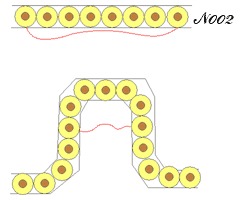
However, until now, we didn't know everything about their formation. Was it the result of the organization of neurons, which implies a genetic evolution, or was it influenced by physical forces?
A team from the John A. Paulson School of Engineering and Applied Sciences at Harvard University created a 3D gel model of a smooth fetal brain and then covered it with a layer of elastomeric gel to reproduce the cortex. The whole was immersed in a liquid that caused the deeper regions to swell. In a few minutes the internal compression induced the formation of folds similar to those of real brains.
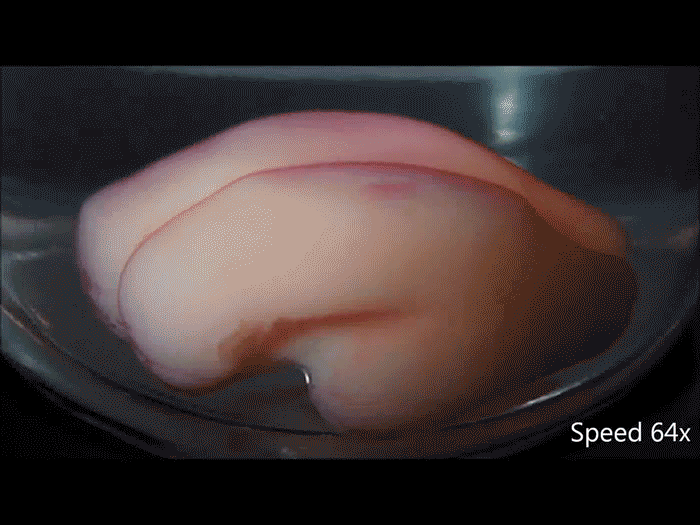 These similarities, between the model and a real brain, lie in the shape which seems to orient the folds in privileged directions.
These similarities, between the model and a real brain, lie in the shape which seems to orient the folds in privileged directions.
Voir aussi : http://news.harvard.edu/gazette/story/2016/02/how-not-why-the-human-brain-folds/
https://www.seas.harvard.edu/news/2016/02/new-research-replicates-folding-of-fetal-human-brain
Deletion of synapses :
Brain cells always begin by forming an excess of connections. Thus, studies carried out in primates have shown that the axons of the visual cells that connect the two eyes to the brain initially overlap. It is later that the paths will separate to define territories dedicated to the processing of information from each eye. We also note that, in the cerebral cortex of the young primate, the connections between neurons are more numerous and twice as dense as those of an adult primate.
Just as in a dense forest, the paths rarely used disappear rapidly, only the connections that generate chemical and electrical signals are preserved.
We find here the same process that exists at the level of memory: the function creates the organ, but it is the organization that creates its efficiency.
Voir aussi : https://www.neurosciences.asso.fr/V2/GrdPublic/pdf/FichesCerveau-Chapitre02.pdf
The five ages of the brain :
Scientists distinguish five periods in the development of the brain.
The first period is during pregnancy. It begins four weeks after fertilization and continues until birth. The first neurons are therefore formed very early, as early as the 28th day of pregnancy when the embryo is no bigger than a grain of rice (5 mm). These neurons reproduce at a rate of 3000 new ones per second.
Thus, by the sixth month, the brain is made up of 90 billion cells. At the same time, they establish a multitude of connections, some of which will be preserved while others will have to disappear: only those that prove useful will remain. This process of cell pruning, which is essential to ensure the future of the living being, is much slower than the process of their multiplication: it will continue for more than 20 years.
Before birth, and because of its immaturity, the brain of the fetus is not very capable of perceiving and recording external events: if it perceives them, it is not able to interpret them. Thus, around the seventh month of pregnancy, it hears the voice of its mother and is able to memorize it. Neurobiologists have been able to demonstrate that babies show a preference for their mother's voice only 12 hours after birth: they will listen more attentively to a story read by their mother when she has already read it to them several times during the last two months of pregnancy.
Mom telling a story
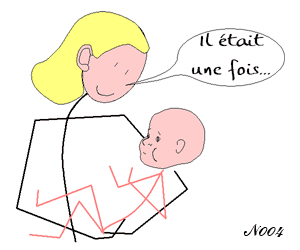
The second period begins at birth and continues until the age of 12. During this period, there is an impressive increase in the number of connections, while the brain shows its ability to respond to the constraints of the environment and to learning.
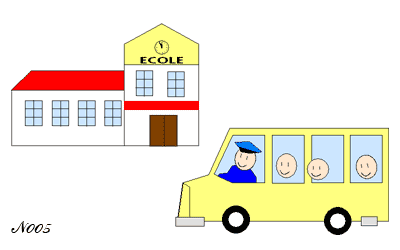
The third period extends from age 12 to 25. This is the time of the great pruning. The adolescent brain selects and strengthens some connections while deleting others. Behavioral changes at this age (fading of instinctive behavior and obedience to rules) will mainly involve brain regions related to social behavior.
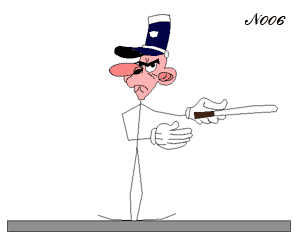
A fourth, much longer period follows and continues until age 65. The brain has reached maturity: during this period it will change little and, contrary to popular belief, it will not lose any more neurons.
In spite of this slowing down of the transformations, the brain will show during all the life a great plasticity, which will allow it to always adapt itself to the new activities or circumstances.
Specifically, if we learn to play a musical instrument, new connections will be established between the auditory and motor areas of the brain. Researchers have also discovered that, during this period, the brain retains the ability to produce new neurons in at least two areas (the hippocampus and the walls of the ventricles) that can improve learning and memory.
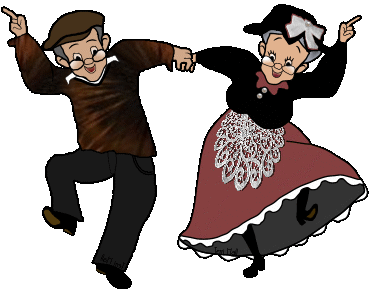
The fifth period begins around the age of 65. The connections between neurons deteriorate, leading to a progressive decline in cognitive abilities. However, by the end of its life, the brain will have lost less than 5% of its neurons.
See also : http://www.francetvinfo.fr/replay-radio/info-sciences/les-cinq-ages-du-cerveau_1764707.html
Sound intensities :
Sound level of a normal voice : 45dB
Raising the voice : 80dB
Screaming : 90dB
Magnetoencephalography :
Magnetoencephalography is a technique for measuring magnetic fields induced by the electrical activity of neurons in the brain.
Vision of a blind man from birth : USA
Vision of a person born blind : GB
A person who is blind from birth, and who may later regain his sight through surgery, will not be able to see because his brain has not learned to recognise the visual environment.
Vision will be recovered gradually from a perception of light and shadow. At first, shapes will be perceived, then, later, he will distinguish objects which he will differentiate, then classify. This is how similar shapes will be differentiated into a stool, table or bed, depending on their use.

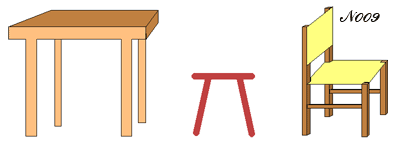
Sleep of the fetus and the newborn :
– before birth :
Thanks to the new capabilities of recording the heartbeat and movements of the fetus by ultrasound, it has been found that the fetus has periods of immobility and periods of agitation. Studies, mainly from the Netherlands, have shown that as early as the twentieth week, the alternation of activity and immobility, lasting 50-60 minutes, is identical to the future sleep cycle of the newborn. Restless sleep (or seismic sleep) and quiet sleep will differentiate from the 27th week of gestation.
According to Okai et al, (1992) stable periods of restless sleep (or seismic sleep) and calm sleep of more than three minutes alternate between 28 and 31 weeks of gestation.
From the 35th or 36th week onwards, these two types of sleep alternate regularly; the period of restless sleep becomes longer, representing about 65% of sleep time. The waking states are almost non-existent.
– During childbirth :
The states of alertness during childbirth.
From 1970 onwards, electroencephalograms carried out during normal deliveries have made it possible to observe that the newborn child sleeps. It only wakes up when the uterine contractions of expulsion are strongest.
– After birth :
A newborn sleeps for an average of 16 hours a day. It is not very sensitive to light and does not have an immediate day-night rhythm.
The sleep cycles, which last on average 50 to 60 minutes, consist of a period of restless sleep and a period of calm sleep.
As long as the circadian rhythm (day-night alternation) has not been established, the newborn's sleep is broken up by awakenings every 3-4 hours: this is known as an ultradian rhythm.
The newborn almost always falls asleep in restless sleep. This phase generally follows a phase of calm wakefulness. The periods of wakefulness are not dependent on feeding, as infants fed by IV or tube also wake up every 3-4 hours.
If we compare the restless sleep of the newborn with the REM sleep of the adult, we can see that their restless sleep represents about 50% of the total sleep (i.e. 8 hours on average), whereas the REM sleep of the adult is only about 2 hours.
The sleep of the child under 3 months.
It is during the first three months that sleep will change the most. Little by little, thanks to the alternation of day and night, and the regularity of the activities offered to him (meals, bedtime...), all the components of adult sleep will appear :
From the age of 2 months, the study of his electroencephalographic activity will make it possible to observe the installation of several equivalent stages of light slow wave sleep and deep sleep of the adult.
Voir :
https://sommeil.univ-lyon1.fr/articles/challamel/rythmes/foetus.php
https://sommeil.univ-lyon1.fr/articles/challamel/rythmes/accouchement.php
https://sommeil.univ-lyon1.fr/articles/challamel/rythmes/premiermois.php
https://sommeil.univ-lyon1.fr/articles/challamel/rythmes/troismois.php
www.ipubli.inserm.fr/bitstream/handle/10608/178/?sequence=8
The phases of sleep in adults :
The sleep cycle is divided into four different stages :
- falling asleep
- light slow wave sleep
- deep slow wave sleep
- REM sleep, which ends the cycle
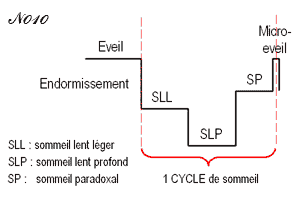 Three to five cycles, lasting approximately 1.5 to 2 hours, follow one another during the night.
Three to five cycles, lasting approximately 1.5 to 2 hours, follow one another during the night.
Within a cycle, the duration of each stage varies according to the time of night.
 Falling asleep :
Falling asleep :
Breathing becomes slower, muscles relax, consciousness decreases. During this half-sleep stage, the muscles may show small contractions, often with the impression of falling into a void.
Light slow wave sleep, stage 2 :
This is not very deep and occupies about 50% of the total sleep time. Eye and muscle activity is reduced. A noise or a light is enough to wake the sleeper during this period. The person remembers having slept.
Deep slow wave sleep, stages 3 and 4 :
The sleeper is more isolated from the outside world : it will be more difficult to wake them up during this phase. This is the time of the cycle when the sleeper recovers from the physical fatigue of the day. The brain emits slow, wide waves. Deep slow wave sleep occupies about 20% of total sleep.
REM sleep, stage 5 :
This phase is called REM sleep because the individual shows both signs of very deep sleep and signs of wakefulness (irregular breathing, elevated heart rate, facial expressions and eye movements). These signs of wakefulness are most often accompanied by the dream.
However, dreaming is not dependent on this phase alone, it can also occur, albeit to a lesser extent, during the deep sleep phase. In this case, it will not be remembered.
This phase represents about 25% of the total sleep time. At the end of a REM sleep phase there is a period of micro-arousal.
Regulation of sleep :
Sleep is regulated in two different ways :
- Homeostatic regulation, which allows the body to regulate its internal equilibrium: thus, the need for a certain amount of restorative sleep leads to an increase in recovery time after a night of insomnia.
- Circadian regulation: under the control of our biological clock, which is itself subject to day-night alternation, it imposes rhythms. The need for sleep is at its highest between 1am and 5am.
https://sommeil.univ-lyon1.fr/articles/challamel/sommenf/nuit.php
In adults, the length of a cycle is very stable throughout life. By observing the length of a night, it is possible to tell whether the subject sleeps in cycles of 90, 100, 110 or 120 minutes.
Sometimes the cycles do not follow each other during the night: a micro-awakening may be prolonged. A large number of sleepers experience wakefulness from 4 to 6 o'clock in the morning, before falling back into a deep sleep.
The characteristics of sleep change throughout the night.
The first two cycles comprise almost all of the deep slow wave sleep. In contrast, light slow wave sleep and REM sleep are more important at the end of the night. The duration of REM sleep periods gradually increases with each cycle, accompanied by greater eye movements.
The amount of deep slow wave sleep depends on the duration of wakefulness and accumulated fatigue. After intense physical activity, the duration of deep slow wave sleep will be greater, whereas a nap will reduce it. Important for the general recovery of the organism, deep slow wave sleep will always be favoured in case of sleep deprivation. With age, it is reduced in favour of light slow wave sleep, sometimes giving the impression of having slept poorly or little.
During the period of micro-awakening that occurs between each cycle, at the end of REM sleep, and if they do not fall back asleep immediately, the most attentive will often be able to recall a dream. Male subjects will find that they have an erection.
In contrast to deep slow wave sleep, the duration of REM sleep does not depend on daytime activity, but on the total duration of the sleep night. In case of sleep deprivation, REM sleep time will only be made up if deep slow wave sleep has allowed a complete recovery.
 http://www.cenas.ch/le-sommeil/comprendre-le-sommeil/phases-du-sommeil/
http://www.cenas.ch/le-sommeil/comprendre-le-sommeil/phases-du-sommeil/
Symbolic representation: :
A major stage in the evolution of thought is the acquisition of symbolic representation: the brain becomes capable of representing absent realities and using these representations to organise an action.
The development of this symbolic function already exists in animals. In humans, it is completed by the ability to evoke objects or situations that are not perceived, by means of signs or symbols. This development is made possible by the prior storage of the perceived object: the object continues to exist outside the field of perception.
Previously (before the age of 2), the child only found answers to situations by trial and error. Once this stage has been reached, they will gradually develop the ability to internalise the action before carrying it out. They will thus be able to imagine the action and carry out successive trials virtually, thus avoiding the risk of errors in real situations. The child then becomes able to differentiate an absent object from its vocal or symbolic representation.
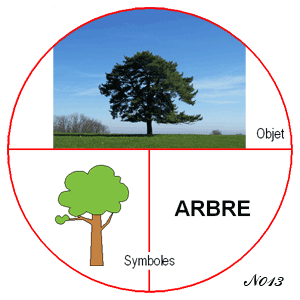 This new faculty is refined through the acquisition of language, drawing, the practice of fictional games, etc.
This new faculty is refined through the acquisition of language, drawing, the practice of fictional games, etc.
Its representational capacity enables the child to symbolically reproduce reality, imitate it or transform it. Games are no longer merely functional, guided by the sensory organs: the child now has access to past events and can anticipate those of the future. Alternating constantly between observation and fiction, they play at being "daddy" or "mummy" by imitating their parents, they also play at war, experiencing in a different way events that they have lived or heard.
The development of memory is an essential element in the elaboration of symbolic representation and the anticipation of situations.
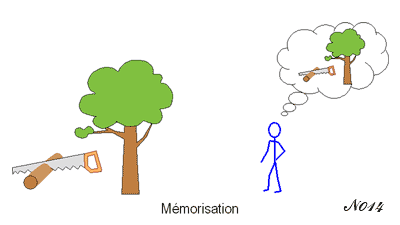
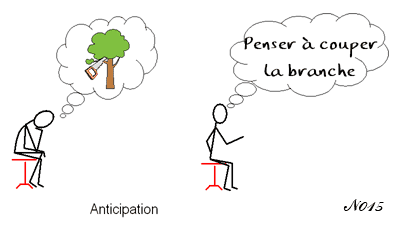
8 intelligences :
The different types of intelligence according to Howard Earl Gardner (born 1943 in Scranton - USA), developmental psychologist, father of the theory of multiple intelligences.
1. Linguistic intelligence... it confers the ability to handle combinations of words, whether for learning, communicating, or even influencing.
2. Logical-mathematical intelligence... is the ability to think abstractly.
3. Spatial intelligence... it allows us to visualise, to find our way in space.
4. Musical intelligence... it allows us to hear and use the sounds and rhythm of music.
5. Bodily-kinesthetic intelligence... this is linked to body awareness and motor skills.
6. Interpersonal intelligence... linked to empathy, it allows for easy social interaction and promotes teamwork.
7. Intrapersonal intelligence... linked to self-representation, it allows one to decipher one's emotions, be aware of one's needs and desires.
8. Naturalist intelligence: it allows us to classify objects, to differentiate them into categories. It is what allows man to understand the world in which he lives.
9. Existential intelligence is defined as the ability to question the meaning and origin of things. It is the intelligence of philosophers and thinkers.
Voir aussi : https://csaffluents.qc.ca/im/PDF2005/ens_outils/Descr_8intell_ill270105.pdf
Intelligence of animals :
Although animals are not distinguished by language, they do possess, to a lesser degree, all the abilities that humans pride themselves on.
Although their linguistic abilities are limited, they do have a language of signs or vocalizations that allows them to communicate information, for example about the presence of a predator.
With regard to logical-mathematical intelligence, they are capable of counting, if only to adapt their reaction to a varied number of predators.
Spatial intelligence is demonstrated in predators by their hunting techniques.
Can we talk about musical intelligence in birds? If the sounds they emit are meaningless melodies for us, albeit pleasant to hear, they are for them both a melody for seducing the beautiful, but also a language for informing potential rivals of their presence, or for organising interrelationships within the family or the group.
There is no need to dwell on the bodily intelligence that enables it to exploit its abilities, whether it is a bird or a mammal.
Interpersonal intelligence facilitates the organisation of groups,
As for intra-personal intelligence, it is indispensable for survival, by knowing its needs, but also by experiencing fear.
Voir : http://www.pourlascience.fr/ewb_pages/a/article-l-intelligence-animale-un-concept-flou-37168.php#kMprv1FGZwthY3BF.99
NdA :
One may wonder about this dissociation. If it is evident in certain pathological states (schizophrenia, autism, etc.), can it be recognised in 'normal' subjects, i.e. those whose behaviour conforms to that of the group they belong to ?
However, it is enough to observe the behaviour of a "gun dealer": focused on his profits, has he retained a hint of empathy for the families destroyed by the bombs? Is a member of a cult whose members all think alike aware that outside his sphere, other men hold a different truth? More commonly, is a head of state with a penchant for the market economy and social inequality aware of the men who are the real engine of that economy? Conversely, is the same head of state who is inclined towards assistance without compensation aware that collective effort contributes to the well-being of everyone ?
Precursor cell :
In the evolutionary transformation that leads from the stem cell to the mature cell, several stages can be distinguished:
- the totipotent stem cell is a cell capable of differentiating into all the cell types that constitute the organism,
- the pluripotent stem cell, capable of giving all cell types, except for the embryonic annexes which do not belong to the embryo but participate in intrauterine life (placenta).
- the multipotent stem cell, capable of giving different cell types within a specific cell line,
- the precursor cell, a stage where the cell is already fully oriented,
- and finally the mature cell.
Pruning :
This pruning process will continue until the age of 20 to 25 years: connections related to unnecessary knowledge or non-existent situations are not retained.
Indeed, growing and developing means learning to inhibit or eliminate certain behaviours, especially those that are not necessary.
The suppression can be temporary (inhibited action), or permanent (unnecessary synapses are removed).
Myelin :
Myelin is a substance made up mainly of lipids (70%) with alternating layers of protides (30%). This substance, contained in Schwann cells and oligodendrocytes, serves to insulate and protect nerve fibres, similar to the plastic covering of electrical wires.
In the central nervous system, it is the oligodendrocytes that perform this function.
In the peripheral axons, it is the Schwann cells. They form a sheath in the form of a discontinuous sleeve: each cell is separated from the next by a space where the axon is exposed: the node of Ranvier. The nerve impulse will propagate by jumping from one node to another: this mode of nerve conduction is used when the speed of an impulse must be fast..
Medial prefrontal cortex :
The prefrontal cortex is the site of various executive functions: logic, planning, strategy, and reasoning.
It is also present at all stages of the memory process (encoding, consolidation, recall). The control it exerts allows it to focus attention, to learn by memorising new data, but also to inhibit interfering information.
The prefrontal cortex is divided into three distinct regions:
- the dorsolateral prefrontal cortex: corresponding to Brodmann's areas 9 and 46, it is involved in working memory, planning, motor control and certain higher intellectual functions.
- Ventrolateral prefrontal cortex: corresponding to Brodmann's areas 44, 45 and 47, it is also involved in working memory, planning and motor control. It is also involved in maintaining attention.
- the orbitofrontal prefrontal cortex: this corresponds to Brodmann areas 10 and 11. Its role is to regulate other brain functions.
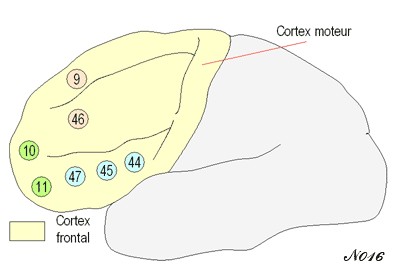 Within this group, the medial prefrontal cortex is the part of the prefrontal cortex that serves as an interface between the cognitive and emotional systems. It is within this cortex that emotions would be consciously experienced.
Within this group, the medial prefrontal cortex is the part of the prefrontal cortex that serves as an interface between the cognitive and emotional systems. It is within this cortex that emotions would be consciously experienced.
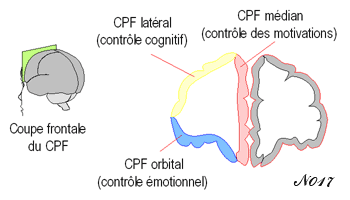 Since 2001, several authors (Daw and O'Doherty) have observed activity in the medial orbitofrontal cortex related to the magnitude of the reward obtained after a specific action.
Since 2001, several authors (Daw and O'Doherty) have observed activity in the medial orbitofrontal cortex related to the magnitude of the reward obtained after a specific action.
The term "reward" is understood here as any benefit for which a subject is willing to expend energy. It is based more on motivation ("I want") than on pleasure ("I like").
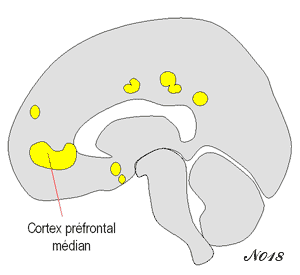
Voir aussi : http://psychologie-cognitive.blogspot.fr/2013/03/lafontaine-et-lippe-2011-le-role-du.html
www.enfant-encyclopedie.com/sites/default/files/docs/.../Glossaire_Cerveau_CPM.pdf
http://sapience.dec.ens.fr/cogmaster/www/doc/MEMOIRES/2010_EKOVICH_Muriel.pdf
Caudate nucleus :
The caudate nucleus of telencephalic origin is one of the three main components of the basal ganglia, together with the putamen and the globus pallidus. The caudate nucleus and the putamen form a functional unit: they are both the entry point for information from the cortex. Once processed, this information will return to the motor cortex via the thalamus.
These ganglia have an indirect role in the motor system: they control the amount of movement performed. Their dysfunction leads to a loss or an excess of movements corresponding to the parkinsonian syndrome or Huntington's chorea.
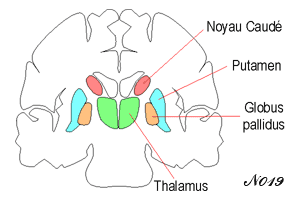 https://fr.wikipedia.org/wiki/Noyau_caud%C3%A9Le noyau caudé d'origine télencéphalique
https://fr.wikipedia.org/wiki/Noyau_caud%C3%A9Le noyau caudé d'origine télencéphalique
http://www.medecine.unige.ch/enseignement/apprentissage/module3/pec/apprentissage/neuroana/1/1.20/1205.htm
2 - Development of the child's abilities :
NDE : (Near death experience)
In NDEs, certain functions of the brain weaken, and the subject loses the visual control of his or her environment that is exercised when awake. It seems then that, in this state, the brain uses certain primitive capacities, while interpreting them with its knowledge of the moment..
Thus, outside of any visual control, the brain will keep the memory of the place where it was during the trauma and will represent itself in this same place. Thanks to the sounds that reach him, he will perceive rescuers around him and be able to locate them.
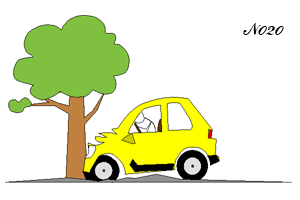
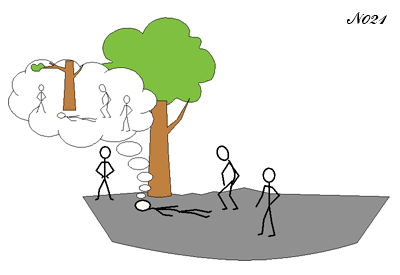
If pharmaceutical smells reach him, his brain will imagine that he has been transported to a hospital. The movements and dialogues between members of the nursing staff will place him in an operating room. If he loses the tactile sensation of the place where he lies, he will perceive that he has left his body and his memory will even allow him to reconstitute the image of his body lying underneath him [cf : Les interprétations erronées de la conscience (in french)].
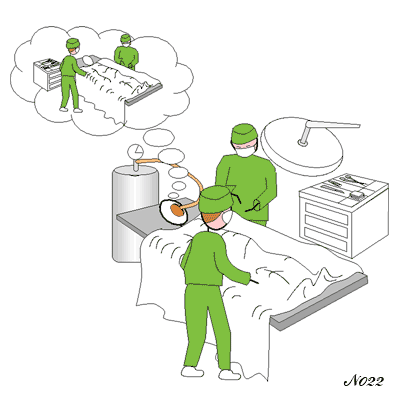
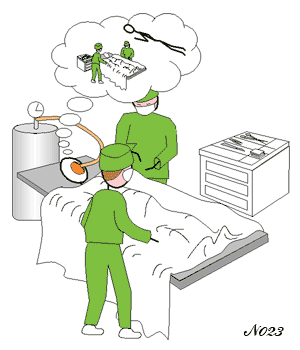
These manifestations, of the order of a temporary hallucination, generally occur before irreversible lesions appear ; they simply reflect a functioning of the brain which reconstitutes reality without having access to all of its senses. Some meditation techniques can also cause transient out-of-body experiences (OBEs).
How can this be explained ?
If one closes one's eyes, one can notice the progressive disappearance of the perception of the contact of one's body on a seat: the sensation of floating in space can then occur.
This mechanism, which occurs during wakefulness, is similar to that which triggers dream imagery. In dreams, the subject is dissociated from bodily sensations and imagery can develop without hindrance.
During REM sleep, the suppression of somatic afferents frees the imagination, an imagination that is most often very close to reality.
See also : https://www.courrierinternational.com/article/2007/08/24/parle-a-mon-corps-ma-tete-est-ailleurs
http://www.francetvinfo.fr/sciences/experience-de-mort-imminente-que-dit-la-science_715079.html
http://lecerveau.mcgill.ca/flash/capsules/outil_bleu26.html
Baby's vision :
A study conducted by Svein Magnussen's team at Uppsala University in Stockholm, Sweden, simulated a baby's visual environment on the basis of the following hypothesis : if adults are unable to identify the expression on a face, it can be assumed that a newborn baby is equally unable.
To this end, a video was shown of faces expressing different emotions (joy, anger, etc.) in succession. At a distance of 30 cm, all 48 participants correctly identified the facial expressions. At 60 cm, identification became more difficult, and was impossible from 120 cm.
This team was able to determine that babies can perceive the facial expressions of those around them long before their vision allows them to recognise the details of their environment.
However, the same researchers were unable to determine whether what they see is meaningful to them.
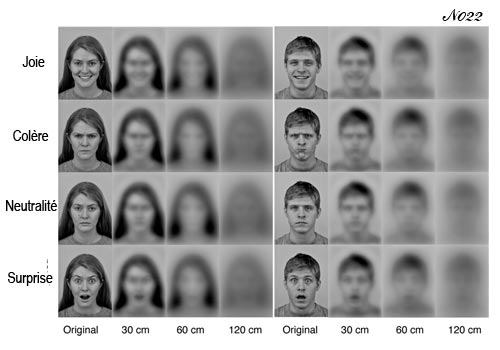
https://www.sciencesetavenir.fr/sante/comment-les-nouveau-nes-percoivent-le-monde_29229
Mirror neurons :
Studied in monkeys, they are located in the premotor cortex (a region involved in the planning and organisation of voluntary movements). These neurons are activated both when the monkey manipulates an object and when it simply observes another monkey manipulating the object.
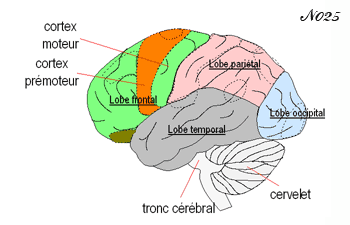 Face recognition :
Face recognition :
In adults, face identification in everyday life involves several levels of processing. First of all, perceptual processing (recognition of facial characteristics (eyes, nose, mouth, etc.), then cognitive processing (recognition of expressions, imitation, memorization, etc.) up to the understanding of other people's intentions.
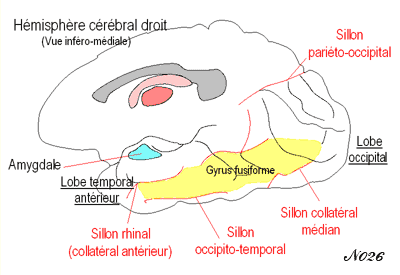
See also prosopagnosia : http://www.cerveauetpsycho.fr/ewb_pages/a/article-la-reconnaissance-des-visages-18752.php
https://hal.archives-ouvertes.fr/tel-01415376/document
Emotions :
When confronted with a disturbing scene, a small brain region, the amygdala, located in the temporal lobe of each cerebral hemisphere, becomes active. It is the centrepiece of our emotional brain and is connected to many other brain regions that cause physiological effects
How does this process work ?
The viewer's retina sends information to the lateral geniculate body of the thalamus, which processes it and then transmits part of it to the visual cortex, which redistributes it to different cortical areas, including the amygdala.
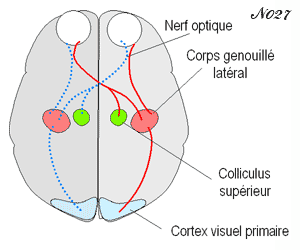
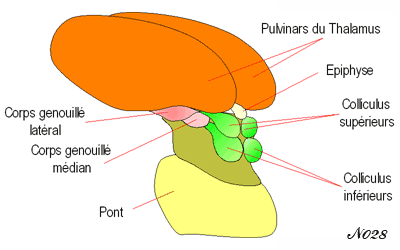
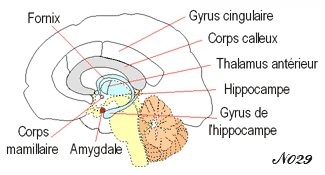
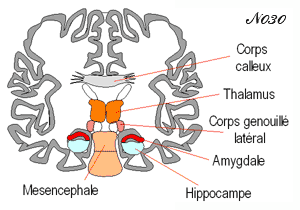
On the other hand, the amygdala has received information from auditory areas that have also processed other components of the scene.
If the signals are consistent, the amygdala reacts strongly. It then activates a whole set of neuronal networks (hypothalamus, brain stem and cortex), triggering the response of the peripheral nervous system, and in particular the vegetative nervous system which controls a large number of somatic functions (heart, respiratory system, sweat glands, etc.).
The emotional reaction is not only immediate, but it even precedes awareness.
In parallel to this pathway, evolution has selected a 'fast pathway' that bypasses the cortex and seems to directly connect a nucleus of the thalamus, the pulvinar, to the amygdala..
It is this pathway that allows us to perceive the emotional content of a scene and to react to it even before becoming aware of its visual content [cf : blind vision].
This emotional state is revealed by measuring heart and breathing rates, skin conduction (modified by sweat caused by emotion), and the measurement of cortisol (stress hormone) in saliva.
However, from physiological measurements it is impossible to determine which emotion was felt. Thus, if you give adrenaline to an individual, you do get physiological effects, but he or she will not necessarily experience an emotion, or even an emotion different from that normally associated with the molecule. In fact, it is the cognitive evaluation of the scene that determines the type of emotion experienced.
On the other hand, the observation of cerebral activations makes it possible to distinguish two major sets of emotions, each corresponding to a cerebral hemisphere.
Richard J. Davidson, Director of the Affective Neuroscience Laboratory at the University of Wisconsin-Madison in the United States, was able to show that the left frontal cortex is more involved in emotions that result in approaching behaviour, whether it is a "positive" emotion where we approach to hug, or a "negative" one where we approach to hit.
Conversely, emotions that lead to avoidance behaviour (fear, disgust, etc.) activate the right frontal cortex more.
For a long time it was thought that the role of the amygdala was limited to fear. In reality, if you remove both amygdalae from a monkey, it becomes totally placid, and even eats food it previously hated.
Partial lesions of the amygdala in humans can lead to inappropriate emotional responses (reduced fear, loss of emotional significance of objects or increased approach behaviour).
There is increasing evidence that the amygdala processes all emotions, and that it has a role in evaluating relevant stimuli related to our five senses (visual, auditory, tactile, olfactory or gustatory): for this purpose it is linked to the orbitofrontal cortex (OFC).
Thus, lesions in the orbitofrontal cortex cause various alterations in behaviour, in groups (violence, loss of control, etc.), or difficulty in making decisions.
There are many more connections from the amygdala to the cortex than vice versa: we can deduce that the amygdala influences our voluntary cortical processes more than our will can act on our emotions. Injunctions such as: "Don't be sad! "show how difficult it can be to control our emotions.
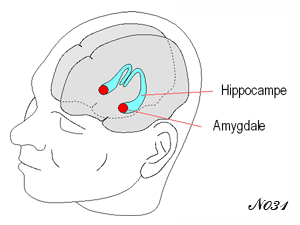 http://traumapsy.com/Ce-qui-se-passe-dans-notre-cerveau.html
http://traumapsy.com/Ce-qui-se-passe-dans-notre-cerveau.html
Jean William Fritz Piaget : ( 1896 - 1980) Swiss-born biologist, psychologist, logician and epistemologist, known for his work in developmental psychology and epistemology through what he called genetic epistemology (or genetic structuralism).
Epistemology (from the Greek for 'true knowledge, science' and 'discourse') refers to two concepts :
- in the French-speaking world : the critical study of science and scientific knowledge;
- in the Anglo-Saxon world : the study of knowledge in general.
https://fr.wikipedia.org/wiki/Jean_Piaget
Alina Szeminska : ( 1907 – 1986) Polish psychologist and university professor, she initiated, with Jean Piaget, the study of numbering and of the child's capacity to construct mental representations, independently of the objects, their diversity, and also of their perceptive property.
https://fr.wikipedia.org/wiki/Alina_Szeminska
Karen Wynn is Professor of Psychology and Cognitive Science at Yale University.
In the experiment she designed, infants are placed in front of a puppet theatre.
With the curtain open, the first doll is presented, then a screen is placed over it. The infant then watches as the researcher places a second doll next to the first, behind the screen.
When the screen is raised, there should be two dolls, but there is only one (1+1=1).
Conversely, three dolls (the number may vary) are presented, and one of them is removed from behind the screen, in full view of the child.
When the screen is raised, there should be two dolls, but there are always three (3-1=3).
During the experiment, the eye fixation times of the newborn are measured. It was found that these times increased, indicating that the infant's attention increased in the face of the abnormal event, i.e. when the result obtained did not correspond to the result of a correct addition or subtraction.
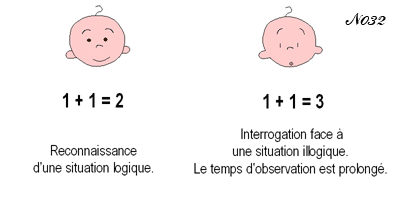 From these observations, K. Wynn was able to conclude that four- and five-month-olds have a precise perception of number, and not just a vague perception between one and many. Moreover, to pass the test, the babies must have acquired object permanence. These experiments raise questions about the nature of these skills: are they cognitive and arithmetical processes or are they perceptual in nature ?
From these observations, K. Wynn was able to conclude that four- and five-month-olds have a precise perception of number, and not just a vague perception between one and many. Moreover, to pass the test, the babies must have acquired object permanence. These experiments raise questions about the nature of these skills: are they cognitive and arithmetical processes or are they perceptual in nature ?
Paradigm of habituation-dishabituation :
An experimental protocol for studying infant memory. It is based on babies' interest in novelty.
The baby is presented with a stimulus and it is observed whether it looks at it for a longer or shorter time. A shortened observation time indicates that the baby's interest in the stimulus is declining: this is the habituation phase.
After a pause of varying length, if the stimulus is presented again, the baby will recognise the stimulus when the visual fixation time increases again : this is the dishabituation phase.
The préfrontal cortex is the anterior part of the frontal lobe cortex of the brain, located in front of the premotor regions.
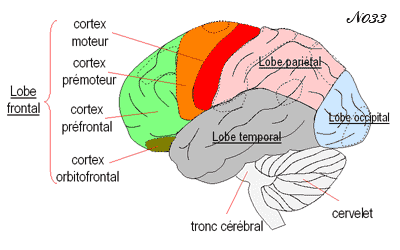
This region is the seat of various so-called higher cognitive functions (language, working memory, reasoning, and generally speaking, executive functions). It is also the region of taste and smell. It is one of the brain areas that has undergone the greatest expansion during the evolution of primates up to hominids.
Voir aussi : https://fr.wikipedia.org/wiki/Cortex_pr%C3%A9frontal
Numbering :
The Pirahãs are members of a tribe of hunter-gatherers in the Amazon, living mainly on the banks of the Rio Maici in Brazil. Their numbers have dwindled considerably over the last few decades (in 2004, their numbers were 340), and their culture is threatened with extinction. Their language (Pirahã) is one of the pillars of their culture and identity. It is a language they can whistle, and this is how they communicate when hunting in the jungle.
They have no vocabulary to describe numbers and only count to two. According to the researchers, they are unable to learn calculation concepts.
Voir aussi : https://fr.wikipedia.org/wiki/Pirah%C3%A3
Cerebellum :
The cerebellum is not the origin of movement, which depends on the motor areas, but it contributes to the coordination and synchronisation of gestures, allowing precise movements. It coordinates signals from different sensory areas, (...) as well as from the spinal cord to regulate motor activity.
The lesions that can occur cause problems with precision of movement, balance, posture and motor learning.
Its scope is very broad, and it is involved in language, attention, mental imagery, and the regulation of fear and pleasure responses.
This unexpected field of action could make it possible to envisage that these capacities, which are generally attributed only to evolved species, could already be in place in the most primitive species.
According to Kenji Doya (Okinawa Institute of Science - Japan), this organ is an automatic learning device, where rules are established from a database of learning from experience.
See also : https://fr.wikipedia.org/wiki/Cervelet
3 - Social development of the child and the appearance of language : (In french)
Pidgin : It has been observed that when adults of different mother tongues live together, they create a 'pidgin', an impoverished language that juxtaposes words from different languages, to communicate with each other.
Children : Children who learn this pseudo language as their mother tongue enrich it by adding conjugations, articles, auxiliaries, etc...
This same phenomenon has been observed with the sign languages used by the deaf.
As a reminder, f.M.R.I. (Functional Magnetic Resonance Imaging) highlights the increase in blood circulation in areas where the increase in cerebral activity requires an increase in oxygen supply.
Executive functions are used to carry out activities such as planning, organising and strategising. They are also used to maintain attention, remember details, and manage time and space.
Noam Chomsky born December 7, 1928 in Philadelphia, is an American linguist. He founded generative linguistics, which accounts for the innate structures that give rise to the "language faculty". This theory is considered the most important contribution to theoretical linguistics in the 20th century.
See also : https://fr.wikipedia.org/wiki/Noam_Chomsky
Syntax : Syntax is originally the branch of grammar that studies how words combine to form sentences or statements in a language.
Visual syntax : By extension, visual syntax studies the way shapes and colours combine to form images and describe environmental situations.
Basic rules of visual syntax :
Syntactic rules are rules of visual transformation, not relationships between stable entities.
In order to understand how visual language works, we must therefore understand that it is more dynamic than geometric, although geometric concepts are necessary to describe it.
- The rules of material organisation :
Neighbourhood gives an impression of continuity between the different ranges of shapes and/or colours.

Separation establishes boundaries between shapes and colours.
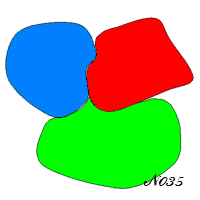
Nesting is perceived when a shape and/or colour range is inserted between two other ranges. This area emphasises the separation while linking the separate elements.
Wrapping further links shapes when some shapes surround others, either totally or partially.
The order of succession of similar shapes creates guidelines as well as movement.
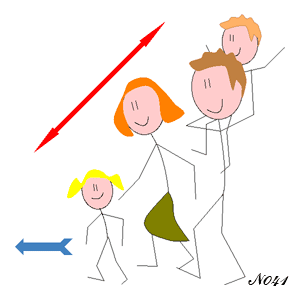
Vectoriality : is a decrease in intensity between a central area and the peripheral areas of a coloured mass
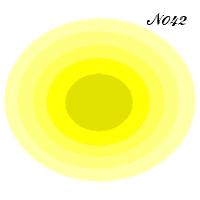
The opening and closing of a region : shapes as visual variables can be open or closed.
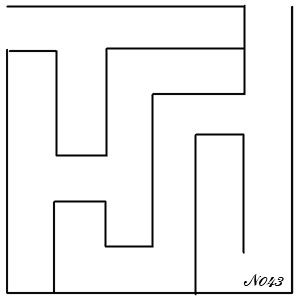
See also : http://www.collegesherbrooke.qc.ca/~bourgech/semiologie/planoriginel/syntaxe.htm
Graphical language :
The graphic or visual programming language is a language in which programs are written by assembling graphic elements. Its concrete syntax consists of graphic symbols and text, which are spatially arranged to form programs. Many visual languages are based on the notions of "boxes and arrows": boxes (or other objects) are treated as entities, connected by arrows or lines that represent relationships..
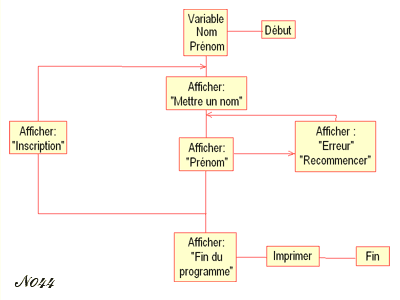
Russian sentence structure :
In the Russian language, word order is flexible. Although the Russian sentence is generally organized subject-verb-object (complement), the rules of grammar allow for almost any combination of: subject, verb and object within the sentence.
For example, the sentence "A cat caught a mouse" can be translated into Russian in the following ways :
Does the meaning change ?
The order of the words does not change the meaning if the sentence is taken out of context, as you can see in the example above.
However, if the sentence is part of a particular arrangement, rearranging the words changes the meaning.
It is known that every complete sentence has a theme and a topic. The theme is one or more words that express information already known or understood. The theme is the new information that a speaker wants to communicate, for example :

The theme is always logically emphasized in Russian. Thus, changing the order of words in the sentence causes this logical emphasis and, finally, the meaning to be changed.
Let's see how the meaning of the sentence is changed according to the word order. The theme (new information) is in bold type.
The emphasis can be placed on the fact that he built a house near a lake.
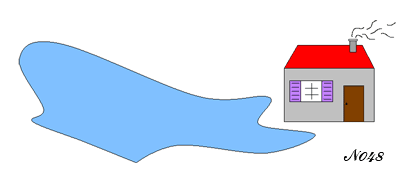
The emphasis can be on the fact that he built a house last year, not this year.

The emphasis can be on the fact that he built a house near a lake, not near a road.
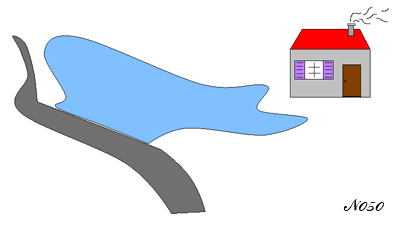
The emphasis can be on the fact that son his friend, not an enemy, built a house near a lake.
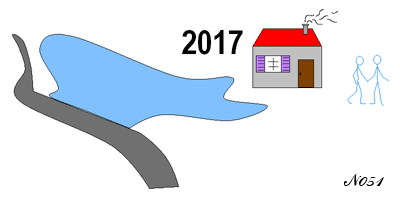
See also : http://masterrussian.com/fr/aa060500a_fr.htm
4 – The child's way of thinking before the age of 4 :
Bayes' theorem :
Bayes' theorem is used to estimate the probability of an event occurring from observations, or the characteristics of a population from those of a small sample of that population. The unavoidable error decreases with increasing sample size.
https://fr.wikipedia.org/wiki/Inf%C3%A9rence_statistique
Statistics in plants :
Biologists have long been interested in plants, but it is only since 2006 that more and more of them have become interested in what has finally been decided to call "plant intelligence".
For Darwin, being intelligent, whether for a human or an animal, meant making the right decision, without presupposing the means by which that action was achieved. However, until now, many scientists considered it heresy to apply to the plant kingdom a notion reserved for the animal kingdom. But biologist Georges Bassel of Birmingham University has observed this decision-making mechanism in a seed that must, at some point, 'decide' whether or not to germinate. How does a small seed determine that the warm day that would allow it to germinate is an isolated day in the winter or the harbinger of spring? This question was answered by the seed cells of the Arabidopsis thaliana.

Without the need for neurons, the cells found at the tip of the radicle have a spatial organisation similar to some of the cognitive systems of the human brain.
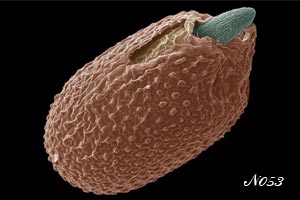
This mechanism involves two types of cells and two hormones:
- the cells located at the periphery are sensitive to cold. They produce abscisic acid, a hormone that puts the radicle to sleep.
- On the other hand, the cells in the centre of the radicle grow when they wake up and produce the growth hormone gibberellin.
Between the two, a transporter diffuses each hormone into the two types of cells, each inhibiting the production of the other.
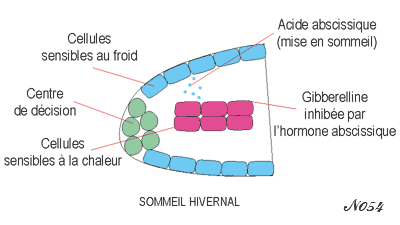
During winter, a temporary increase in temperature has little effect on the synthesis of growth hormone. It is the temperature fluctuations that gradually bring the growth hormone to the periphery of the radicle and inhibit the sleep hormone.
If the amplitude and duration of the temperature increases are insufficient, the seed will not germinate.
But if the gibberellin reaches the periphery in a sustainable way, it will indicate the coming of spring.
This mechanism is identical to the one that determines the functioning of a swarm.
Swarms and artificial intelligence :
Current artificial intelligence is resolutely oriented towards learning without human intervention. Thus, a system dedicated to language will discover by itself the words, grammar and style of the writer, without knowing the deep meaning of the text.
These systems are inspired by the behaviour and decision-making capabilities of swarms of bees, flocks of birds or schools of fish.
These systems have also been studied in human groups. To do this, a group of individuals is confronted with a question and each individual, in real time, observes the behaviour of the group, chooses to change or reinforce his or her attitude, while an algorithm analyses the behaviour of each individual, his or her strength of conviction and answers the question based on the functioning of natural swarms.
In 2018, 40 non-professional swarming individuals predicted the winners of the Oscars with 94% success. Similarly, in 2016, the swarm predicted the order of arrival of the first four horses in a Kentucky derby, whereas no individual, taken separately, could have given the exact order.
It is therefore understandable that plants, made up of millions of cells, can do without a brain, since they are their own brain.
Moreover, how do our brain cells respond to the constraints of the environment? Working in swarms, they find all the answers they need, whereas none of them could have done so separately.
Could it be that the primary function of our brain-organ, which is so fast in its reactions, is to ensure movement towards food, before moving on to abstraction ?
http://www.sauvagesdupoitou.com/86/668
https://www.science-et-vie.com/nature-et-enviro/revelations-sur-l-intelligence-des-plantes-48091
http://www.up-magazine.info/index.php/technologies-a-la-pointe/lab/8545-les-graines-des-plantes-ont-en-elles-une-memoire-du-climat
Science et Vie 1203
Science et Vie 1219
Exact result :
Statistics are very important when it comes to drawing conclusions from a variable result.
Let's take the example of a maths problem in a primary school class. Out of 20 students, 10 will have the average, one will have zero (wrong solution) and one will have 20/20 (right solution).
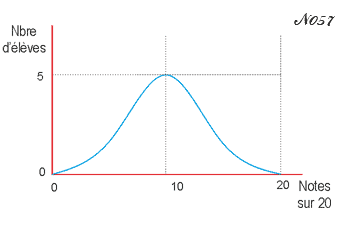
It follows that statistics cannot indicate the exact answer to a problem. However, they do accurately describe the average level of a class. They will then allow the necessary measures to be taken to improve this general level. Generally speaking, they allow progress in all areas, both in adapting to the real world and in abstract knowledge
Number idea :
Mathematics has at least two symbolic representations: words and Indo-Arabic numbers. Used throughout the world, the latter operate in base 10, i.e. the code changes when the number 10 is reached: the numeration then switches to two digits. This code is linked to the anatomy of human hands: by analogy, our fingers represent the number 10.
Counting in base 10 means counting to infinity using our ten fingers as a base.
Learning to read :
Initially, our brain does not contain neurons designed for reading. However, its plasticity allows it to adapt to these new constraints.
Writing is in fact too recent a development in human history to have been written into our genetic make-up. It does not contain instructions or pre-established circuits for reading. Only the effort of learning allows us to recycle certain regions dedicated to other activities in order to acquire this new capacity.
We have seen that the 2-month-old baby already activates the language areas of his left hemisphere when he listens to sentences in his mother tongue [cf : 03-language / language skills at 3 months]. This hemisphere already has the neural circuits that respond to speech, and distinguish between close syllables like 'ba' and 'da'. Although the baby does not yet have a memory for words, it has the ability to produce and then imitate sounds, before being able to modulate and remember them.
Thus, long before being able to read, the child masters language. Brain imaging shows that, from the very first months of life (in utero?), a baby who hears his mother tongue already activates the same brain regions as an adult.
How is speech acquired in the brain ?
Hearing is essential for language. The first transformation was therefore to link the auditory area to the language areas.
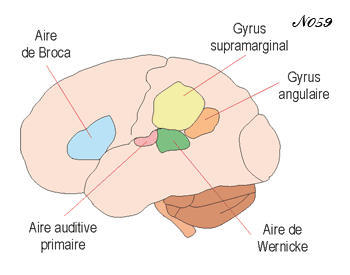
Reading, on the other hand, depends on visual areas, which are able to recognise surrounding shapes and in particular faces.
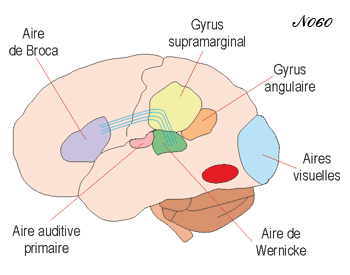
The brain does not have neurons dedicated to reading. It will have to create this new functionality.
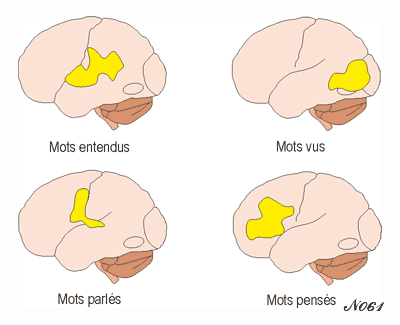
To be able to read, the vision neurons will have to pass two tests: change their speciality to recognise letters and words, then establish a link with the word spoken by the language areas.
This ability to transform is found at all stages of evolution, and in all established structures.
During reading, and after 100 ms, activation begins in the occipital visual area [1].
70 ms later, it spreads to the left temporo-occipital region [2].
Then, multiple regions become activated in the areas of hearing, speech, including the frontal cortex [3].
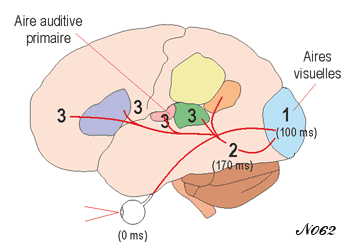
Three regions can be distinguished in the visual areas,:
- a region for object recognition,
- a region for recognising faces,
- a region assigned to landscape recognition,
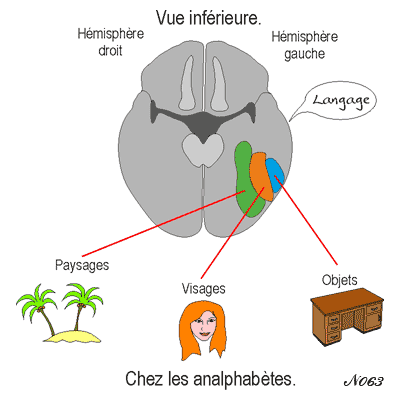
Why the preference for the left hemisphere ?
Because of the presence of language areas.
However, if the left occipitotemporal region is removed during the years of learning to read, the symmetrical region of the right hemisphere will take over.
Learning to read involves accessing, through vision, the areas of spoken language that are already in place in the child.
So what happens in the brain during learning to read ?
In 2010, an international team of researchers compared the brain activity of illiterate adults with that of people who were literate as children or adults. Study coordinated by Stanislas Dehaene (Collège de France, CEA-Inserm-Université Paris Sud 11 Cognitive Neuroimaging Unit, NeuroSpin/I2BM) and Laurent Cohen (Inserm, AP-HP, Université Pierre et Marie Curie).
In illiterate people, the visual area of the left hemisphere is used for object and face recognition. During learning, the response to faces decreases slightly while the response to reading increases.
Brain activation to faces is then partly transferred to the right hemisphere. The cells of the visual cortex show themselves capable of adapting to new needs and, in doing so, of abandoning an old ability to acquire a new one.
https://moncerveaualecole.com/le-cerveau-avant-la-lecture/
http://www.lecerveau.mcgill.ca/flash/pop/pop_pres/upop2013_2%20-%20pour%20pdf.pdf
https://www.u-psud.fr/fr/presse/archives/impact_de_l_apprentissage_de_la_lecture_sur_le_cerveau.html
https://presse.inserm.fr/impact-de-lapprentissage-de-la-lecture-sur-le-cerveau/14997/
https://icm-institute.org/fr/actualite/cerveau-lecture-et-ecriture/
Handling :
The adult's habit, as soon as he spots the numbers, is to read them right side up and from left to right. He will then calculate according to visible criteria such as, here, the repetition of the numbers 6 and 8, and he will look for series...
Instead, the child will manipulate the sheet of paper and, having turned it over, will discover the solution.
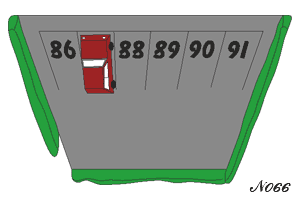
Montaigne, Comenius, William James :
Michel Eyquem de Montaigne (1533-1592), lord of Montaigne (Dordogne), was, according to academic traditions, either a Renaissance philosopher and moralist or a scholarly writer, precursor and founder of the "human and historical sciences" in the French language.
Comenius (1592-1670), was a Czech philosopher, grammarian and pedagogue.
William James (1842-1910) was an American psychologist and philosopher. He is often presented as the founder of psychology in America.
Phonological awareness :
Phonological awareness is the awareness that words are composed of phonemes or sounds. It allows us to perceive, chop up and manipulate the sound units of language such as the syllable, the rhyme and the phoneme. In French, there are about 36 phonemes that can be arranged to form any word in the language.
The phoneme : A phoneme is the smallest sound unit in spoken language. If we look at the letter, a phoneme corresponds to its sound. E.g.: the letter f corresponds to the phoneme ffff.
The syllable : A syllable is the fusion of phonemes that naturally cut up a word when pronounced. Ex: trunk = co and fre..
The rhyme : is made up of the vowel and the following phonemes. Ex: art = a and rt
Le graphème : est la manière dont est transcrit le d’un phonème. Ainsi, le phonème [o] peut s’écrire o – au – eau.
The grapheme : is the way in which a phoneme is transcribed. For example, the phoneme [o] can be written o - au - water.
5 – The baby, from dependence to autonomy :
Cathartic treatment :
Cathartic treatment, developed by the Austrian physician Josef Breuer, is a method using hypnosis to break down the psychological barriers that inhibit the patient's traumatic memories. These memories, which have become inaccessible, are the cause of many disorders. Being able to recall them in this way creates an emotional release that is often liberating.
Object permanence :
This is the child's knowledge that the objects around him exist when it perceives them through his senses, but also that they continue to exist, even if it no longer perceives them.
Jean Piaget, theorist of this phenomenon, thought that the child acquires this knowledge between 8 and 12 months, during the so-called sensory-motor stage of development.
New methods of observation, such as the transgression of expectations developed by Renée Baillargeon (Professor of Psychology at the University of Illinois Urbana-Champaign) in 1987, have suggested that object permanence is earlier. If we look at the eyes of infants, we see that they have expectations of objects as early as 5 months of age. However, this result remains controversial.
https://fr.wikipedia.org/wiki/Permanence_de_l%27objet
Mirror neurons:
These are neurons in the brain that are activated both when an individual performs an action and when he observe another individual performing the same action. They also activate when they imagine that action.
Considered a major discovery in neuroscience, they are thought to play a role in learning by imitation and in affective processes, such as empathy.
https://courspsycho.blog4ever.com/les-neurones-miroirs
However, their activation remains variable depending on the circumstances.
a - Impossible action :
They only activate when the movement is real, for example if the arm goes around a part of the body. If the arm passes through the body, the mirror neurons do not activate.
b - Unknown action :
For the child and the monkey who have not learned to perform a gesture, the mirror neurons do not activate.
It is essential to have acquired a motor representation of the action, whatever it may be, for the mirror system to be activated. It is not possible to represent an action if one has not mastered it.
c - Imitated action :
Mirror neurons are activated when we observe and then imitate.
d - Mimed or performed action :
In humans, miming the action of grasping an object generates much less activity than actually grasping the object.
In the monkey, on the other hand, the neurons do not activate if we simply pretend to grasp an object. Their representational capacity only takes into account the reality of the facts.
It is not only the motor representation of gestures that is activated.
Other brain areas are involved, such as :
- the primary and secondary somato-sensory cortices in the sensation of being touched.
- the secondary somato-sensory cortex when observing someone else being touched.
Finally, this mirror system includes other systems without necessarily having mirror neurons.
Thus, when object permanence is acquired, it is not necessary to see the end of the action to see them activate.
See also :
INSERM https://apprendreaeduquer.fr/une-animation-pour-decouvrir-les-neurones-miroirs/
Appearance of language :
Towards the end of the first year and up to about 18 months, the infant utters his first words. At around 18-24 months, he or she begins to combine two words and then several words into an articulate output. Between 20 and 30 months, the child begins to use elements of syntax, such as pronouns or plural endings. Similarly, they will use grammar rules and generalise them.
The area in which mirror neurons are found corresponds to Broca's area, which specialises in spoken language.
Broca's area also controls the hands. This finding leads to the hypothesis that understanding gesture language is the first step before creating words to describe these gestures.
6– The consciousness of the child :
Introspection Network :
Study by David Edward, Imperial College London, of the brains of fetuses from 29 weeks and newborns up to the second month.
Primates :
There are many orders of mammals, with man belonging to the order of primates, whose oldest representatives are dated to 55 million years ago.
Within this order, man belongs to the family of "hominoidae" where he is related to the gibbon, the orang-utan, the gorilla and the chimpanzee. The particularity of the hominoidae is the absence of a tail. Their common ancestor acquired a nose instead of a nose (truffle), he has no vibrissae, his orbits are closed, his nostrils are open downwards, he has no third premolars and above all his caudal vertebrae are reduced to a coccyx.
A comparison of homologous genes between hominoidae indicates that human genes have greater similarities with those of the chimpanzee than with those of the gorilla, orangutan and gibbon. Together they belong to the 'hominini' branch. The chimpanzee is now considered to be the closest species to humans.
Initially, the human lineage evolved only in Africa. In the course of this evolution, "Homo sapiens" appeared 200,000 years ago and from 70,000 years ago onwards, they invaded all regions of the world, displacing the older Homo populations.
https://www.annabac.com/cours-en-ligne/l-homme-un-primate-au-sein-des-primates
https://planet-vie.ens.fr/thematiques/evolution/hominoides-hominides-hominines-et-les-autres
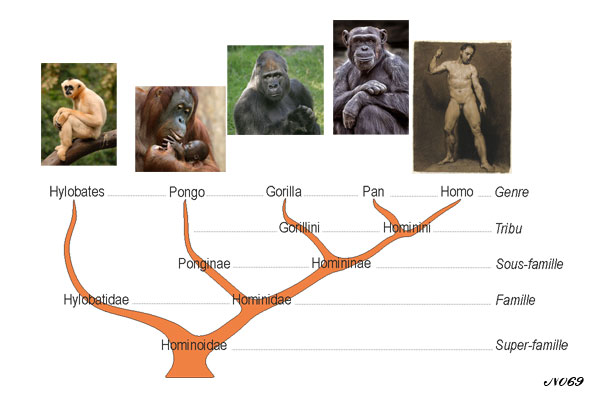 >
>
Reasoning by analogy :
An analogy is a comparison, a correspondence, a relationship of resemblance between two things, two people, two situations or two different concepts that have physical, intellectual, moral, etc. commonalities.
The thought process that characterises it consists in noticing a similarity between two things, of different nature or class. In fact, if the comparison concerns two things or persons of the same type, it is a resemblance,
whereas if they are of a different class, it is an analogy.
Analogical reasoning also allows us to match a previous situation to a new one that resembles it.
Emmanuelle Volle, a neuroscientist in the team of Bruno Dubois and Richard Lévy, has shown that reasoning by analogy depends on the most anterior region of the left prefrontal cortex. This cerebral network would allow the matching and integration of the elements necessary to form an analogy.
http://www.toupie.org/Dictionnaire/Analogie.htm https://icm-institute.org/fr/actualite/le-raisonnement-par-analogie-revisite/
fMRI :
Functional Magnetic Resonance Imaging (fMRI) is an adaptation of Magnetic Resonance Imaging that provides an indirect view of brain activity. Used to study brain function, it consists of recording local cerebral variations in blood flow when these areas are activated. Indeed, any neuronal activation will be accompanied by a local increase in blood flow in order to cover the metabolic needs linked to this activation. This will change the local ratio of oxyhaemoglobin to deoxyhaemoglobin, resulting in a magnetic signal that can be measured (BOLD signal).
More recently, techniques have also been developed to identify the fibres linking the brain areas together (diffusion method, or tractography).
https://fr.wikipedia.org/wiki/Imagerie_par_r%C3%A9sonance_magn%C3%A9tique_fonctionnelle
https://www.sciencedirect.com/science/article/abs/pii/S1957255714706777
https://www.cerveauetpsycho.fr/sd/neurosciences/voir-le-cerveau-penser-7238.php
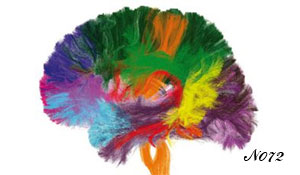
Alison Gopnik : (born June 16, 1955) is an American professor of psychology and affiliate professor of philosophy at the University of California, Berkeley. She is known for her work in the areas of cognitive development and language, specialising in the effect of language on thought, the development of a theory of mind and causal learning.
(Le bébé philosophe. Ed Le Pommier 2010)
Mutatis mutandis : is a Latin locution, literally meaning: "what had to be changed having been changed", and which could be translated in a more current way as: "Once the necessary changes have been made". This locution thus indicates to the reader that we are going to proceed with an analogy, with a comparison of two similar situations, from which we will voluntarily subtract the dissimilarities "that must be changed" so that a comparison can take place.
Access consciousness : is the consciousness that allows us to act rationally. This consciousness would be the one on which neuroscience can work.
The notion of access consciousness is relational: it is conscious because of the relationships it has with our other thoughts, actions and speech. It is also a functional notion: conscious states are defined as those that govern reasoning and control voluntary movements.
https://fr.wikipedia.org/wiki/Ned_Block
Phenomenal consciousness : refers to the capacity to be the subject of conscious experience. It defines consciousness as a set of experiences that characterise a subject's 'experience' or 'feeling'. Unlike consciousness defined as "cognition", phenomenal consciousness is associated with qualitative experience, such as the perception of colours, the feeling of hot or cold, the feeling of anxiety, etc.
Unlike access consciousness, it is said to be non-relational and non-functional.
There are arguments for distinguishing the two consciousnesses.
Ned Block offers an everyday example that shows that there can be phenomenal consciousness without access consciousness: "I hear a lawnmower outside, and without realising it I start talking louder. Later, at some point, I realise this, and then I reason and decide to go and close the window. In a sense I was aware of the lawnmower from the start, in another sense I became aware of it at the moment I decided to close the window.
The initial awareness is phenomenal awareness, the next is access awareness. Ned Block also proposes to use this distinction to understand the Freudian notion of the unconscious. An unconscious event, according to this analysis, is a conscious event in the sense of phenomenal consciousness but not in the sense of access consciousness.
https://fr.wikipedia.org/wiki/Conscience_ph%C3%A9nom%C3%A9nale
https://fr.wikipedia.org/wiki/Ned_Block
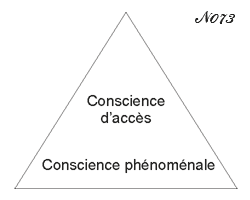
Statistics in babies : The statistical frequency of sounds influences the brain of toddlers.
In a study of 6-month-olds in Seattle, USA, and Stockholm, Sweden, it was shown that each group was already focusing on the vowels of their native language. The language environment starts to permeate the baby's brain at an early age and influences the way the baby perceives sounds.
It seems that learning sounds between 6 and 12 months of age establishes connections in the brain associated with the child's mother tongue and those to which the child is exposed during this period.
A second form of statistical language learning allows children to recognise words as a whole: Jenny Saffran, now at the University of Wisconsin at Madison, and her colleagues were the first to discover that babies use statistical learning to pick up the sounds of whole words. In the mid-1990s, they published data showing that an 8-month-old child learns basic word-like units based on the probability that one syllable will follow another.
Statistics is the discipline that studies phenomena through the collection of data, their processing, analysis, interpretation of results and presentation to make the data understandable to all. It is at the same time a science, a method and a set of techniques.
https://www.pourlascience.fr/sd/neurosciences/le-bebe-un-linguiste-en-herbe-9145.php
https://fr.wikipedia.org/wiki/Statistique
Causal reasoning : is reasoning based on the principle that every fact has a cause and that a cause produces effects. This reasoning is often used to explain a fact, in a simple, sometimes naive, but understandable way, in science or in everyday life.
https://www.fondation-lamap.org/fr/page/34822/le-raisonnement-causal-chez-lenfant
Antonio Damasio , professor of neuroscience, neurology and psychology, heads the Brain and Creativity Institute at the University of Southern California, Los Angeles.
He is an adjunct professor at the Salk Institute in La Jolla.
Evolution of the nervous system :
In animals, the central nervous system integrates sensory information and sends motor commands throughout the body. In vertebrates, the brain has a peripheral cortex organised into cell layers, whereas in arthropods and annelid worms, it is characterised by the presence of rounded sensory structures, the pedunculated bodies. However, it seems that an outline of the vertebrate nervous system was already established in the Precambrian: the cerebral cortex of vertebrates and the pedunculated bodies of annelids would have the same ancestral origin: a nervous structure that differentiated in a common ancestor living in the sea 600 to 550 million years ago.
From this common origin, more than 500 million years of divergent evolution have made them very different.
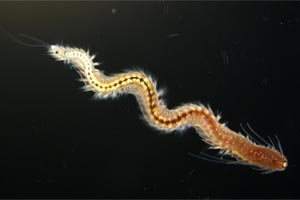
By studying larvae of the marine annelid worm Platynereis dumerilii, the researchers produced a 3D genetic map of the developing pedunculated bodies, which they compared with that of the pedunculated bodies of the Drosophila embryo and that of the cerebral cortex, or pallium, of the mouse embryo.
The researchers concluded that the two molecular fingerprints are "too similar to be of independent origin, so these organisms must have a common precursor".
Urbilateria, the possible common ancestor, is thought to resemble a kind of marine worm with one or more neural nuclei capable of integrating sensory signals from the environment. Later, this basic neural plan would have evolved into more complex structures until it reached the level we know in mammals.
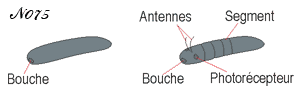
https://www.pourlascience.fr/sd/neurosciences/un-cerveau-ancestral-de-600-millions-dannees-10679.php
Homeostasis balance : Defined by Claude Bernard, it is the capacity of any system to maintain its functional equilibrium despite external constraints (regulation of temperature, blood sugar...).
Protoself : The "self" refers to the knowledge of the self, emerging from the perceptual-motor system, which allows one to distinguish and differentiate oneself from the rest of the world.
In its most primitive form, it is referred to as protosoi.
Produced by the protosoi and originating in the brain stem, the primordial feelings (pleasure and pain) reflect the state of the body. They then expand into the various emotional feelings. Even the most complex mental images that are not feelings exist only because they are coupled with feelings.
https://fr.wikipedia.org/wiki/Ant%C3%B3nio_Dam%C3%A1sio
The thalamus : The thalamus is the main diencephalic nucleus. Its many nuclear subdivisions relay motor, sensory, sensory and associative information.
It is thought to be involved in :
- in the waking state, in the transfer and filtering of peripheral sensory information to the cortex, and in the general activation of the cerebral cortex (vigilance).
- during slow wave sleep, in the disconnection of the cortex from sensory stimuli, and in memory consolidation processes.
http://www.chups.jussieu.fr/ext/neuranat/morphologie/GanglionsBase/index.html https://fr.wikipedia.org/wiki/Thalamus
Basal ganglia :
The anatomical definition of the basal ganglia includes:
- the zoom striated body (putamen, globus pallidus and caudate nucleus)
- the claustrum (front wall)
- the amygdala
The amygdala complex is usually studied as part of the limbic system.br>br> The ventral tegmental area (VTA), a group of neurons located in the centre of the brain, is particularly important in the reward circuit. It receives information from several other regions that inform it about the level of satisfaction of basic or more specifically human needs.
Scientists have discovered two different signals carried by two types of neurons that run through the motivational circuit in the ventral pallidum. Inhibitory signals are responsible for reward-seeking and pleasure-seeking behaviour, and excitatory signals cause the mice to flee from stress.
The amygdala is a collection of subcortical nuclei located in the rostral medial temporal lobe. The different nuclei are :
- the basolateral nuclei which receive projections from the cortical sensory and associative areas of the temporal lobe and insula.
- the central nuclei which participate in emotional responses. They receive viscerosensory afferents from the solitary and parabrachial nuclei, as well as from the basolateral nuclei of the amygdala.
- The corticomedial nuclei exchange information with the olfactory bulb. They are thought to be involved in the emotional regulation of olfactory stimuli (feeding and reproductive behaviour).br> http://lecerveau.mcgill.ca/flash/d/d_03/d_03_cr/d_03_cr_que/d_03_cr_que.html
https://www.sciencesetavenir.fr/sante/cerveau-et-psy/comment-le-cerveau-trace-t-il-la-frontiere-entre-plaisir-et-douleur-essentielle-a-notre-motivation_140247
https://fr.wikipedia.org/wiki/Syst%C3%A8me_limbique
Merging with the Universe : Shamans or Buddhist monks, among others, train to modulate their brain waves through meditation or techniques leading to trance or ecstatic state. In the West, other methods grouped in the teaching of sophrology aim to study or obtain changes in the state of consciousness. In all these methods the subject loses more or less the notion of self, space and time.
In the most extreme states, the subject can experience total fusion with the universe, with a feeling of wisdom and infinite love.
https://www.sciencesetavenir.fr/sante/cerveau-et-psy/le-cerveau-dans-tous-ses-etats_107838
https://www.pourlascience.fr/sd/neurosciences/comment-la-meditation-modifie-le-cerveau-8322.php
Insects and personality : Ants reveal the incredible ability of insects to act like the most advanced organisms. They are able to associate and cooperate for the common good. Building complex shelters or searching for food, some may also find no employment at all. They may also wage war against other colonies and take slaves.
In Côte d'Ivoire, observations of the fight between these insects and termites have revealed quasi-military habits and a very efficient army health service.
In 2017, researchers observed members of the Megaponera analis family rescuing one of them, carrying it and returning it to the nest. Since then, they have been able to film ants applying their antibacterial saliva to the wounds of their wounded victims, which enables them to fight infection. This technique allows them to save 80% of their fellow ants.
https://www.lemonde.fr/sciences/article/2018/03/12/les-fourmis-redoutables-strateges-militaires_5269745_1650684.html
Kingdom of heaven :
It goes without saying that we will not take this term here in its religious sense, but in its metaphorical sense, i.e. "living happily".
The place of the child in the Bible and the Gospels :
1 - The child in the biblical world :
Texts from ;
https://biblehub.com - New International Version
https://www.biblegateway.com
In the Old Testament, the child, and in particular the boy, is always a gift from God. It values the father, and it is not so much the birth as the fertility that is a source of joy for the mother: indeed, for the Israelite women, sterility is a source of shame, and fertility is the means of existing under the gaze of man.
Psalms 127:3 "Children are a heritage from the LORD, offspring a reward from him."
Gen 30:1 When Rachel saw that she was not bearing Jacob any children, she became jealous of her sister. So she said to Jacob, "Give me children, or I'll die!"
1 Samuel 1.11 And she made a vow, pleading, “O LORD of Hosts, if only You will look upon the affliction of Your maidservant and remember me, not forgetting Your maidservant but giving her a son, then I will dedicate him to the LORD all the days of his life, and no razor shall ever come over his head.”
Luke 1:24.25 After this his wife Elizabeth became pregnant and for five months remained in seclusion. She declared, "The Lord has done this for me," she said. "In these days he has shown his favor and taken away my disgrace among the people."
Thus, if the absence of a child is a shame, the child is not idealized. On the contrary, from the moment of his birth, he participates in the collective sin.
He lacks judgment : 1 Cor 14:20 Brothers and sisters, stop thinking like children. In regard to evil be infants, but in your thinking be adults.
And he must be severely educated : Proverbs 13:24 Whoever spares the rod hates their children, but the one who loves their children is careful to discipline them.
Proverbs 22:15 Folly is bound up in the heart of a child, but the rod of discipline will drive it far away.
Sirach 30.1-13 Education
1 - A father who loves his son will whip him often, so that he can be proud of him later.
2 - If a son is disciplined, he will be of some use, and his father can boast of him to his friends.
3 - Anyone who gives good guidance to his son cannot only take pride in him among his friends, but he can make his enemies jealous.
4 - 5 While the father is alive, the sight of his son makes him happy, and when he dies, he has no regrets. He is not really dead, because his son is like him.
6 - He has left someone to take vengeance on his enemies and to return the favors he owes his friends.
7 - But anyone who spoils his son will have to bandage his wounds. His heart will stop every time he hears a shout.
8 - An untamed horse is going to be stubborn, and an undisciplined son is no different.
9 - If you pamper your child and play with him, he will be a disappointment and a source of grief.
10 - Laugh with him now, and one day you will have to cry over him, grinding your teeth in regret.
11 - Don't give him freedom while he is young, and don't overlook what he does wrong.
12 - Whip him while he is still a child, and make him respect your authority. If you don't, he will be stubborn and disobedient and cause you nothing but sorrow
13 - So discipline your son and give him work to do, or else he will be an embarrassment to you.
To sum up, the importance of children is not because of their moral qualities or their intrinsic value, but because they ensure the future of the People of Israel.
2 - L’enfant dans les évangiles :
"Let the children come to me".
The vision of Christ in the Gospels is quite different.
The first episode concerns children who are brought to Jesus to be touched (Mark 10,13-16). Is it their respect for their Master that causes Jesus' disciples to dismiss these children as too insignificant to hold his attention ? Was it because they were still under the influence of tradition that they reproached him for accepting their presence ? In any case, their reaction provokes Jesus' intervention : "When Jesus saw this, he was indignant. He said to them, "Let the little children come to me, and do not hinder them, for the kingdom of God belongs to such as these." (Mark 10: 14).
This is followed by a teaching on welcoming the Kingdom of God :
Mark 10:15 "Truly I tell you, anyone who will not receive the kingdom of God like a little child will never enter it.".
After showing that it is not because of their exceptional religious dispositions that the Kingdom of God belongs to children, Jesus indicates here the only possible way to "enter the Kingdom": to trust, to abandon oneself into the hands of God, to surrender to the omnipotence of his love. He will later complete his teaching: one does not enter the Kingdom by one's own merits or success in life, but by the pure spirit of a child : Matthew 5:3 "Blessed are the poor in spirit, for theirs is the kingdom of heaven."
Matthew :
18:01 At that time the disciples came to Jesus and asked, "Who, then, is the greatest in the kingdom of heaven?"
18:02 He called a little child to him, and placed the child among them.
18:03 And he said: "Truly I tell you, unless you change and become like little children, you will never enter the kingdom of heaven.
Another moment when Jesus talks about children is reported in the Gospels of (Mk Mt and Lk).
Matthew :
18:4 Therefore whoever humbles himself like this little child will be the greatest in the kingdom of heaven.
18:5 And whoever welcomes one such child in my name welcomes me.
Luke :
9:47 Jesus, knowing their thoughts, took a little child and had him stand beside him.
9:48 Then he said to them, "Whoever welcomes this little child in my name welcomes me; and whoever welcomes me welcomes the one who sent me. For it is the one who is least among you all who is the greatest."
In these stories, the child's place is again advanced: not only is the door to another world opened to him, but also to the world of men. The race for power or recognition is not relevant: "Being" is the only important thing.
The child definitively leaves the status of evil ignoramus that he occupied in the Old Testament to become a model. If God created man with a simple mind, and if he gave him the means to live simply, in the present and content to be in his place, it is so that he would be the first to reach the "Kingdom". Simplicity is the way to happiness, and to live one's life in happiness is to be the first, the best.
However, as adults (in this case his disciples) are not always able to understand the obvious, he clarifies his thinking :
Mark :
9:33 They came to Capernaum. When he was in the house, he asked them, "What were you arguing about on the road?"
9:34 But they kept quiet because on the way they had argued about who was the greatest.
9:35 Sitting down, Jesus called the Twelve and said, "Anyone who wants to be first must be the very last, and the servant of all."
9:36 He took a little child whom he placed among them. Taking the child in his arms, he said to them :
9:37 "Whoever welcomes one of these little children in my name welcomes me; and whoever welcomes me does not welcome me but the one who sent me."
Mark :
10:43 "Not so with you. Instead, whoever wants to become great among you must be your servant,
10:44 and whoever wants to be first must be slave of all."
Apart from a simple mind, what else differentiates the child from the adult? Not having yet the strength to fight or to fight the others, he has the intelligence to learn, and he has everything to learn from life.
We can see the evolution of human thought from the god of the kingdom of Judah, a god federating many idols and losing his companion Ashera [cf : The paths of the exodus], to the one narrated in the texts borrowed during the exile in Babylon.
Voir aussi : https://fr.wikipedia.org/wiki/Exil_%C3%A0_Babylone
https://fr.wikipedia.org/wiki/Royaume_de_Juda

What do we really know about Jesus? He left no written record, and none of his contemporaries, apart from his disciples, spoke of him or represented him. The texts themselves vary in translation: in some texts he is called a Nazarene (from Nazareth, which is an "ethnic" name), in others he is called a "Nazorene", that is, an "observer" (belonging to a religious movement). This difference, which persists in the Greek Bibles, no longer exists in the Bibles translated from Latin.
However, although there is no formal proof of the existence of Jesus, other than indirect stories told in the second half of the first century, it is impossible to ignore a change in the thinking of the time.
Whether the words transcribed in the gospels are those of this man, blasphemer for the Jews, prophet for the Muslims, son of God for the Christians, they initiate a radical transformation of the way of seeing the world and human relations: the exclusions that existed in the society of the time, such as that which affected children, are denounced, and the multiple commandments (*) will be reduced to a single injunction: "love one another".
John 15:12 "My command is this: Love each other as I have loved you.".
(*) According to the classification of Moses Maimonides, a Sephardic rabbi of the 12th century, 613 commandments govern behavior. They are divided into 248 positive commandments "thou shalt do", and 365 negative commandments "thou shalt not do".
Voir aussi : http://www.dossiers-archeologie.com/numero-249/jesus-regard-l-histoire/judee-l-occupation-romaine.4170.php#article_4170
http://histoire-geographie.ac-dijon.fr/IMG/pdf/Les_rapports_entre_christianisme_et_Etat_romain1.pdf
Brain Circumvolutions :
How are the folds of the brain formed?
The brain of a human fetus is smooth for the first 20 weeks, then its surface begins to fold in on itself. This process continues until the child is about 18 months old.
Cerebral convolutions, the characteristic folds of the brain, have evolved to increase the surface area of the cortex while the volume of the cranium limits its expansion. This mechanism has two advantages: folding increases the surface area of the cortex and, consequently, the number of neurons, and the distances to be covered between two folds are shorter, which accelerates exchanges.

A fold contains more cells, and the connections between cells are shorter.
However, until now, we didn't know everything about their formation. Was it the result of the organization of neurons, which implies a genetic evolution, or was it influenced by physical forces?
A team from the John A. Paulson School of Engineering and Applied Sciences at Harvard University created a 3D gel model of a smooth fetal brain and then covered it with a layer of elastomeric gel to reproduce the cortex. The whole was immersed in a liquid that caused the deeper regions to swell. In a few minutes the internal compression induced the formation of folds similar to those of real brains.

Voir aussi : http://news.harvard.edu/gazette/story/2016/02/how-not-why-the-human-brain-folds/
https://www.seas.harvard.edu/news/2016/02/new-research-replicates-folding-of-fetal-human-brain
Deletion of synapses :
Brain cells always begin by forming an excess of connections. Thus, studies carried out in primates have shown that the axons of the visual cells that connect the two eyes to the brain initially overlap. It is later that the paths will separate to define territories dedicated to the processing of information from each eye. We also note that, in the cerebral cortex of the young primate, the connections between neurons are more numerous and twice as dense as those of an adult primate.
Just as in a dense forest, the paths rarely used disappear rapidly, only the connections that generate chemical and electrical signals are preserved.
We find here the same process that exists at the level of memory: the function creates the organ, but it is the organization that creates its efficiency.
Voir aussi : https://www.neurosciences.asso.fr/V2/GrdPublic/pdf/FichesCerveau-Chapitre02.pdf
The five ages of the brain :
Scientists distinguish five periods in the development of the brain.
The first period is during pregnancy. It begins four weeks after fertilization and continues until birth. The first neurons are therefore formed very early, as early as the 28th day of pregnancy when the embryo is no bigger than a grain of rice (5 mm). These neurons reproduce at a rate of 3000 new ones per second.
Thus, by the sixth month, the brain is made up of 90 billion cells. At the same time, they establish a multitude of connections, some of which will be preserved while others will have to disappear: only those that prove useful will remain. This process of cell pruning, which is essential to ensure the future of the living being, is much slower than the process of their multiplication: it will continue for more than 20 years.
Before birth, and because of its immaturity, the brain of the fetus is not very capable of perceiving and recording external events: if it perceives them, it is not able to interpret them. Thus, around the seventh month of pregnancy, it hears the voice of its mother and is able to memorize it. Neurobiologists have been able to demonstrate that babies show a preference for their mother's voice only 12 hours after birth: they will listen more attentively to a story read by their mother when she has already read it to them several times during the last two months of pregnancy.
Mom telling a story

The second period begins at birth and continues until the age of 12. During this period, there is an impressive increase in the number of connections, while the brain shows its ability to respond to the constraints of the environment and to learning.

The third period extends from age 12 to 25. This is the time of the great pruning. The adolescent brain selects and strengthens some connections while deleting others. Behavioral changes at this age (fading of instinctive behavior and obedience to rules) will mainly involve brain regions related to social behavior.

A fourth, much longer period follows and continues until age 65. The brain has reached maturity: during this period it will change little and, contrary to popular belief, it will not lose any more neurons.
In spite of this slowing down of the transformations, the brain will show during all the life a great plasticity, which will allow it to always adapt itself to the new activities or circumstances.
Specifically, if we learn to play a musical instrument, new connections will be established between the auditory and motor areas of the brain. Researchers have also discovered that, during this period, the brain retains the ability to produce new neurons in at least two areas (the hippocampus and the walls of the ventricles) that can improve learning and memory.

The fifth period begins around the age of 65. The connections between neurons deteriorate, leading to a progressive decline in cognitive abilities. However, by the end of its life, the brain will have lost less than 5% of its neurons.
See also : http://www.francetvinfo.fr/replay-radio/info-sciences/les-cinq-ages-du-cerveau_1764707.html
Sound intensities :
Sound level of a normal voice : 45dB
Raising the voice : 80dB
Screaming : 90dB
Magnetoencephalography :
Magnetoencephalography is a technique for measuring magnetic fields induced by the electrical activity of neurons in the brain.
Vision of a blind man from birth : USA
Vision of a person born blind : GB
A person who is blind from birth, and who may later regain his sight through surgery, will not be able to see because his brain has not learned to recognise the visual environment.
Vision will be recovered gradually from a perception of light and shadow. At first, shapes will be perceived, then, later, he will distinguish objects which he will differentiate, then classify. This is how similar shapes will be differentiated into a stool, table or bed, depending on their use.

Learning to see.

While the classification is taking place, the cognitive memory is being set up.
Sleep of the fetus and the newborn :
– before birth :
Thanks to the new capabilities of recording the heartbeat and movements of the fetus by ultrasound, it has been found that the fetus has periods of immobility and periods of agitation. Studies, mainly from the Netherlands, have shown that as early as the twentieth week, the alternation of activity and immobility, lasting 50-60 minutes, is identical to the future sleep cycle of the newborn. Restless sleep (or seismic sleep) and quiet sleep will differentiate from the 27th week of gestation.
According to Okai et al, (1992) stable periods of restless sleep (or seismic sleep) and calm sleep of more than three minutes alternate between 28 and 31 weeks of gestation.
From the 35th or 36th week onwards, these two types of sleep alternate regularly; the period of restless sleep becomes longer, representing about 65% of sleep time. The waking states are almost non-existent.
– During childbirth :
The states of alertness during childbirth.
From 1970 onwards, electroencephalograms carried out during normal deliveries have made it possible to observe that the newborn child sleeps. It only wakes up when the uterine contractions of expulsion are strongest.
– After birth :
A newborn sleeps for an average of 16 hours a day. It is not very sensitive to light and does not have an immediate day-night rhythm.
The sleep cycles, which last on average 50 to 60 minutes, consist of a period of restless sleep and a period of calm sleep.
As long as the circadian rhythm (day-night alternation) has not been established, the newborn's sleep is broken up by awakenings every 3-4 hours: this is known as an ultradian rhythm.
The newborn almost always falls asleep in restless sleep. This phase generally follows a phase of calm wakefulness. The periods of wakefulness are not dependent on feeding, as infants fed by IV or tube also wake up every 3-4 hours.
If we compare the restless sleep of the newborn with the REM sleep of the adult, we can see that their restless sleep represents about 50% of the total sleep (i.e. 8 hours on average), whereas the REM sleep of the adult is only about 2 hours.
The sleep of the child under 3 months.
It is during the first three months that sleep will change the most. Little by little, thanks to the alternation of day and night, and the regularity of the activities offered to him (meals, bedtime...), all the components of adult sleep will appear :
From the age of 2 months, the study of his electroencephalographic activity will make it possible to observe the installation of several equivalent stages of light slow wave sleep and deep sleep of the adult.
Voir :
https://sommeil.univ-lyon1.fr/articles/challamel/rythmes/foetus.php
https://sommeil.univ-lyon1.fr/articles/challamel/rythmes/accouchement.php
https://sommeil.univ-lyon1.fr/articles/challamel/rythmes/premiermois.php
https://sommeil.univ-lyon1.fr/articles/challamel/rythmes/troismois.php
www.ipubli.inserm.fr/bitstream/handle/10608/178/?sequence=8
The phases of sleep in adults :
The sleep cycle is divided into four different stages :
- falling asleep
- light slow wave sleep
- deep slow wave sleep
- REM sleep, which ends the cycle

Within a cycle, the duration of each stage varies according to the time of night.

Breathing becomes slower, muscles relax, consciousness decreases. During this half-sleep stage, the muscles may show small contractions, often with the impression of falling into a void.
Light slow wave sleep, stage 2 :
This is not very deep and occupies about 50% of the total sleep time. Eye and muscle activity is reduced. A noise or a light is enough to wake the sleeper during this period. The person remembers having slept.
Deep slow wave sleep, stages 3 and 4 :
The sleeper is more isolated from the outside world : it will be more difficult to wake them up during this phase. This is the time of the cycle when the sleeper recovers from the physical fatigue of the day. The brain emits slow, wide waves. Deep slow wave sleep occupies about 20% of total sleep.
REM sleep, stage 5 :
This phase is called REM sleep because the individual shows both signs of very deep sleep and signs of wakefulness (irregular breathing, elevated heart rate, facial expressions and eye movements). These signs of wakefulness are most often accompanied by the dream.
However, dreaming is not dependent on this phase alone, it can also occur, albeit to a lesser extent, during the deep sleep phase. In this case, it will not be remembered.
This phase represents about 25% of the total sleep time. At the end of a REM sleep phase there is a period of micro-arousal.
Regulation of sleep :
Sleep is regulated in two different ways :
- Homeostatic regulation, which allows the body to regulate its internal equilibrium: thus, the need for a certain amount of restorative sleep leads to an increase in recovery time after a night of insomnia.
- Circadian regulation: under the control of our biological clock, which is itself subject to day-night alternation, it imposes rhythms. The need for sleep is at its highest between 1am and 5am.
https://sommeil.univ-lyon1.fr/articles/challamel/sommenf/nuit.php
In adults, the length of a cycle is very stable throughout life. By observing the length of a night, it is possible to tell whether the subject sleeps in cycles of 90, 100, 110 or 120 minutes.
Sometimes the cycles do not follow each other during the night: a micro-awakening may be prolonged. A large number of sleepers experience wakefulness from 4 to 6 o'clock in the morning, before falling back into a deep sleep.
The characteristics of sleep change throughout the night.
The first two cycles comprise almost all of the deep slow wave sleep. In contrast, light slow wave sleep and REM sleep are more important at the end of the night. The duration of REM sleep periods gradually increases with each cycle, accompanied by greater eye movements.
The amount of deep slow wave sleep depends on the duration of wakefulness and accumulated fatigue. After intense physical activity, the duration of deep slow wave sleep will be greater, whereas a nap will reduce it. Important for the general recovery of the organism, deep slow wave sleep will always be favoured in case of sleep deprivation. With age, it is reduced in favour of light slow wave sleep, sometimes giving the impression of having slept poorly or little.
During the period of micro-awakening that occurs between each cycle, at the end of REM sleep, and if they do not fall back asleep immediately, the most attentive will often be able to recall a dream. Male subjects will find that they have an erection.
In contrast to deep slow wave sleep, the duration of REM sleep does not depend on daytime activity, but on the total duration of the sleep night. In case of sleep deprivation, REM sleep time will only be made up if deep slow wave sleep has allowed a complete recovery.

Symbolic representation: :
A major stage in the evolution of thought is the acquisition of symbolic representation: the brain becomes capable of representing absent realities and using these representations to organise an action.
The development of this symbolic function already exists in animals. In humans, it is completed by the ability to evoke objects or situations that are not perceived, by means of signs or symbols. This development is made possible by the prior storage of the perceived object: the object continues to exist outside the field of perception.
Previously (before the age of 2), the child only found answers to situations by trial and error. Once this stage has been reached, they will gradually develop the ability to internalise the action before carrying it out. They will thus be able to imagine the action and carry out successive trials virtually, thus avoiding the risk of errors in real situations. The child then becomes able to differentiate an absent object from its vocal or symbolic representation.

Its representational capacity enables the child to symbolically reproduce reality, imitate it or transform it. Games are no longer merely functional, guided by the sensory organs: the child now has access to past events and can anticipate those of the future. Alternating constantly between observation and fiction, they play at being "daddy" or "mummy" by imitating their parents, they also play at war, experiencing in a different way events that they have lived or heard.
The development of memory is an essential element in the elaboration of symbolic representation and the anticipation of situations.

Recognising and remembering different objects.

Representation and anticipation based on symbols.
8 intelligences :
The different types of intelligence according to Howard Earl Gardner (born 1943 in Scranton - USA), developmental psychologist, father of the theory of multiple intelligences.
1. Linguistic intelligence... it confers the ability to handle combinations of words, whether for learning, communicating, or even influencing.
2. Logical-mathematical intelligence... is the ability to think abstractly.
3. Spatial intelligence... it allows us to visualise, to find our way in space.
4. Musical intelligence... it allows us to hear and use the sounds and rhythm of music.
5. Bodily-kinesthetic intelligence... this is linked to body awareness and motor skills.
6. Interpersonal intelligence... linked to empathy, it allows for easy social interaction and promotes teamwork.
7. Intrapersonal intelligence... linked to self-representation, it allows one to decipher one's emotions, be aware of one's needs and desires.
8. Naturalist intelligence: it allows us to classify objects, to differentiate them into categories. It is what allows man to understand the world in which he lives.
9. Existential intelligence is defined as the ability to question the meaning and origin of things. It is the intelligence of philosophers and thinkers.
Voir aussi : https://csaffluents.qc.ca/im/PDF2005/ens_outils/Descr_8intell_ill270105.pdf
Intelligence of animals :
Although animals are not distinguished by language, they do possess, to a lesser degree, all the abilities that humans pride themselves on.
Although their linguistic abilities are limited, they do have a language of signs or vocalizations that allows them to communicate information, for example about the presence of a predator.
With regard to logical-mathematical intelligence, they are capable of counting, if only to adapt their reaction to a varied number of predators.
Spatial intelligence is demonstrated in predators by their hunting techniques.
Can we talk about musical intelligence in birds? If the sounds they emit are meaningless melodies for us, albeit pleasant to hear, they are for them both a melody for seducing the beautiful, but also a language for informing potential rivals of their presence, or for organising interrelationships within the family or the group.
There is no need to dwell on the bodily intelligence that enables it to exploit its abilities, whether it is a bird or a mammal.
Interpersonal intelligence facilitates the organisation of groups,
As for intra-personal intelligence, it is indispensable for survival, by knowing its needs, but also by experiencing fear.
Voir : http://www.pourlascience.fr/ewb_pages/a/article-l-intelligence-animale-un-concept-flou-37168.php#kMprv1FGZwthY3BF.99
NdA :
One may wonder about this dissociation. If it is evident in certain pathological states (schizophrenia, autism, etc.), can it be recognised in 'normal' subjects, i.e. those whose behaviour conforms to that of the group they belong to ?
However, it is enough to observe the behaviour of a "gun dealer": focused on his profits, has he retained a hint of empathy for the families destroyed by the bombs? Is a member of a cult whose members all think alike aware that outside his sphere, other men hold a different truth? More commonly, is a head of state with a penchant for the market economy and social inequality aware of the men who are the real engine of that economy? Conversely, is the same head of state who is inclined towards assistance without compensation aware that collective effort contributes to the well-being of everyone ?
Precursor cell :
In the evolutionary transformation that leads from the stem cell to the mature cell, several stages can be distinguished:
- the totipotent stem cell is a cell capable of differentiating into all the cell types that constitute the organism,
- the pluripotent stem cell, capable of giving all cell types, except for the embryonic annexes which do not belong to the embryo but participate in intrauterine life (placenta).
- the multipotent stem cell, capable of giving different cell types within a specific cell line,
- the precursor cell, a stage where the cell is already fully oriented,
- and finally the mature cell.
Pruning :
This pruning process will continue until the age of 20 to 25 years: connections related to unnecessary knowledge or non-existent situations are not retained.
Indeed, growing and developing means learning to inhibit or eliminate certain behaviours, especially those that are not necessary.
The suppression can be temporary (inhibited action), or permanent (unnecessary synapses are removed).
Myelin :
Myelin is a substance made up mainly of lipids (70%) with alternating layers of protides (30%). This substance, contained in Schwann cells and oligodendrocytes, serves to insulate and protect nerve fibres, similar to the plastic covering of electrical wires.
In the central nervous system, it is the oligodendrocytes that perform this function.
In the peripheral axons, it is the Schwann cells. They form a sheath in the form of a discontinuous sleeve: each cell is separated from the next by a space where the axon is exposed: the node of Ranvier. The nerve impulse will propagate by jumping from one node to another: this mode of nerve conduction is used when the speed of an impulse must be fast..
Medial prefrontal cortex :
The prefrontal cortex is the site of various executive functions: logic, planning, strategy, and reasoning.
It is also present at all stages of the memory process (encoding, consolidation, recall). The control it exerts allows it to focus attention, to learn by memorising new data, but also to inhibit interfering information.
The prefrontal cortex is divided into three distinct regions:
- the dorsolateral prefrontal cortex: corresponding to Brodmann's areas 9 and 46, it is involved in working memory, planning, motor control and certain higher intellectual functions.
- Ventrolateral prefrontal cortex: corresponding to Brodmann's areas 44, 45 and 47, it is also involved in working memory, planning and motor control. It is also involved in maintaining attention.
- the orbitofrontal prefrontal cortex: this corresponds to Brodmann areas 10 and 11. Its role is to regulate other brain functions.


The term "reward" is understood here as any benefit for which a subject is willing to expend energy. It is based more on motivation ("I want") than on pleasure ("I like").

Activations of the medial prefrontal cortex
when a reward is obtained.
when a reward is obtained.
Voir aussi : http://psychologie-cognitive.blogspot.fr/2013/03/lafontaine-et-lippe-2011-le-role-du.html
www.enfant-encyclopedie.com/sites/default/files/docs/.../Glossaire_Cerveau_CPM.pdf
http://sapience.dec.ens.fr/cogmaster/www/doc/MEMOIRES/2010_EKOVICH_Muriel.pdf
Caudate nucleus :
The caudate nucleus of telencephalic origin is one of the three main components of the basal ganglia, together with the putamen and the globus pallidus. The caudate nucleus and the putamen form a functional unit: they are both the entry point for information from the cortex. Once processed, this information will return to the motor cortex via the thalamus.
These ganglia have an indirect role in the motor system: they control the amount of movement performed. Their dysfunction leads to a loss or an excess of movements corresponding to the parkinsonian syndrome or Huntington's chorea.

http://www.medecine.unige.ch/enseignement/apprentissage/module3/pec/apprentissage/neuroana/1/1.20/1205.htm
2 - Development of the child's abilities :
NDE : (Near death experience)
In NDEs, certain functions of the brain weaken, and the subject loses the visual control of his or her environment that is exercised when awake. It seems then that, in this state, the brain uses certain primitive capacities, while interpreting them with its knowledge of the moment..
Thus, outside of any visual control, the brain will keep the memory of the place where it was during the trauma and will represent itself in this same place. Thanks to the sounds that reach him, he will perceive rescuers around him and be able to locate them.


Memory and sounds recreate the scene.
If pharmaceutical smells reach him, his brain will imagine that he has been transported to a hospital. The movements and dialogues between members of the nursing staff will place him in an operating room. If he loses the tactile sensation of the place where he lies, he will perceive that he has left his body and his memory will even allow him to reconstitute the image of his body lying underneath him [cf : Les interprétations erronées de la conscience (in french)].

The perception of odours will change the scene and the place.

Similarly, the loss of tactile sensation will give the illusion of flying over the scene.
These manifestations, of the order of a temporary hallucination, generally occur before irreversible lesions appear ; they simply reflect a functioning of the brain which reconstitutes reality without having access to all of its senses. Some meditation techniques can also cause transient out-of-body experiences (OBEs).
How can this be explained ?
If one closes one's eyes, one can notice the progressive disappearance of the perception of the contact of one's body on a seat: the sensation of floating in space can then occur.
This mechanism, which occurs during wakefulness, is similar to that which triggers dream imagery. In dreams, the subject is dissociated from bodily sensations and imagery can develop without hindrance.
During REM sleep, the suppression of somatic afferents frees the imagination, an imagination that is most often very close to reality.
See also : https://www.courrierinternational.com/article/2007/08/24/parle-a-mon-corps-ma-tete-est-ailleurs
http://www.francetvinfo.fr/sciences/experience-de-mort-imminente-que-dit-la-science_715079.html
http://lecerveau.mcgill.ca/flash/capsules/outil_bleu26.html
Baby's vision :
A study conducted by Svein Magnussen's team at Uppsala University in Stockholm, Sweden, simulated a baby's visual environment on the basis of the following hypothesis : if adults are unable to identify the expression on a face, it can be assumed that a newborn baby is equally unable.
To this end, a video was shown of faces expressing different emotions (joy, anger, etc.) in succession. At a distance of 30 cm, all 48 participants correctly identified the facial expressions. At 60 cm, identification became more difficult, and was impossible from 120 cm.
This team was able to determine that babies can perceive the facial expressions of those around them long before their vision allows them to recognise the details of their environment.
However, the same researchers were unable to determine whether what they see is meaningful to them.

Svein Magnussen/ Journal of Vision
https://www.sciencesetavenir.fr/sante/comment-les-nouveau-nes-percoivent-le-monde_29229
Mirror neurons :
Studied in monkeys, they are located in the premotor cortex (a region involved in the planning and organisation of voluntary movements). These neurons are activated both when the monkey manipulates an object and when it simply observes another monkey manipulating the object.

In adults, face identification in everyday life involves several levels of processing. First of all, perceptual processing (recognition of facial characteristics (eyes, nose, mouth, etc.), then cognitive processing (recognition of expressions, imitation, memorization, etc.) up to the understanding of other people's intentions.

Anatomy of the ventral occipitotemporal cortex.
See also prosopagnosia : http://www.cerveauetpsycho.fr/ewb_pages/a/article-la-reconnaissance-des-visages-18752.php
https://hal.archives-ouvertes.fr/tel-01415376/document
Emotions :
When confronted with a disturbing scene, a small brain region, the amygdala, located in the temporal lobe of each cerebral hemisphere, becomes active. It is the centrepiece of our emotional brain and is connected to many other brain regions that cause physiological effects
How does this process work ?
The viewer's retina sends information to the lateral geniculate body of the thalamus, which processes it and then transmits part of it to the visual cortex, which redistributes it to different cortical areas, including the amygdala.




On the other hand, the amygdala has received information from auditory areas that have also processed other components of the scene.
If the signals are consistent, the amygdala reacts strongly. It then activates a whole set of neuronal networks (hypothalamus, brain stem and cortex), triggering the response of the peripheral nervous system, and in particular the vegetative nervous system which controls a large number of somatic functions (heart, respiratory system, sweat glands, etc.).
The emotional reaction is not only immediate, but it even precedes awareness.
In parallel to this pathway, evolution has selected a 'fast pathway' that bypasses the cortex and seems to directly connect a nucleus of the thalamus, the pulvinar, to the amygdala..
It is this pathway that allows us to perceive the emotional content of a scene and to react to it even before becoming aware of its visual content [cf : blind vision].
This emotional state is revealed by measuring heart and breathing rates, skin conduction (modified by sweat caused by emotion), and the measurement of cortisol (stress hormone) in saliva.
However, from physiological measurements it is impossible to determine which emotion was felt. Thus, if you give adrenaline to an individual, you do get physiological effects, but he or she will not necessarily experience an emotion, or even an emotion different from that normally associated with the molecule. In fact, it is the cognitive evaluation of the scene that determines the type of emotion experienced.
On the other hand, the observation of cerebral activations makes it possible to distinguish two major sets of emotions, each corresponding to a cerebral hemisphere.
Richard J. Davidson, Director of the Affective Neuroscience Laboratory at the University of Wisconsin-Madison in the United States, was able to show that the left frontal cortex is more involved in emotions that result in approaching behaviour, whether it is a "positive" emotion where we approach to hug, or a "negative" one where we approach to hit.
Conversely, emotions that lead to avoidance behaviour (fear, disgust, etc.) activate the right frontal cortex more.
For a long time it was thought that the role of the amygdala was limited to fear. In reality, if you remove both amygdalae from a monkey, it becomes totally placid, and even eats food it previously hated.
Partial lesions of the amygdala in humans can lead to inappropriate emotional responses (reduced fear, loss of emotional significance of objects or increased approach behaviour).
There is increasing evidence that the amygdala processes all emotions, and that it has a role in evaluating relevant stimuli related to our five senses (visual, auditory, tactile, olfactory or gustatory): for this purpose it is linked to the orbitofrontal cortex (OFC).
Thus, lesions in the orbitofrontal cortex cause various alterations in behaviour, in groups (violence, loss of control, etc.), or difficulty in making decisions.
There are many more connections from the amygdala to the cortex than vice versa: we can deduce that the amygdala influences our voluntary cortical processes more than our will can act on our emotions. Injunctions such as: "Don't be sad! "show how difficult it can be to control our emotions.

Jean William Fritz Piaget : ( 1896 - 1980) Swiss-born biologist, psychologist, logician and epistemologist, known for his work in developmental psychology and epistemology through what he called genetic epistemology (or genetic structuralism).
Epistemology (from the Greek for 'true knowledge, science' and 'discourse') refers to two concepts :
- in the French-speaking world : the critical study of science and scientific knowledge;
- in the Anglo-Saxon world : the study of knowledge in general.
https://fr.wikipedia.org/wiki/Jean_Piaget
Alina Szeminska : ( 1907 – 1986) Polish psychologist and university professor, she initiated, with Jean Piaget, the study of numbering and of the child's capacity to construct mental representations, independently of the objects, their diversity, and also of their perceptive property.
https://fr.wikipedia.org/wiki/Alina_Szeminska
Karen Wynn is Professor of Psychology and Cognitive Science at Yale University.
In the experiment she designed, infants are placed in front of a puppet theatre.
With the curtain open, the first doll is presented, then a screen is placed over it. The infant then watches as the researcher places a second doll next to the first, behind the screen.
When the screen is raised, there should be two dolls, but there is only one (1+1=1).
Conversely, three dolls (the number may vary) are presented, and one of them is removed from behind the screen, in full view of the child.
When the screen is raised, there should be two dolls, but there are always three (3-1=3).
During the experiment, the eye fixation times of the newborn are measured. It was found that these times increased, indicating that the infant's attention increased in the face of the abnormal event, i.e. when the result obtained did not correspond to the result of a correct addition or subtraction.

Paradigm of habituation-dishabituation :
An experimental protocol for studying infant memory. It is based on babies' interest in novelty.
The baby is presented with a stimulus and it is observed whether it looks at it for a longer or shorter time. A shortened observation time indicates that the baby's interest in the stimulus is declining: this is the habituation phase.
After a pause of varying length, if the stimulus is presented again, the baby will recognise the stimulus when the visual fixation time increases again : this is the dishabituation phase.
The préfrontal cortex is the anterior part of the frontal lobe cortex of the brain, located in front of the premotor regions.

This region is the seat of various so-called higher cognitive functions (language, working memory, reasoning, and generally speaking, executive functions). It is also the region of taste and smell. It is one of the brain areas that has undergone the greatest expansion during the evolution of primates up to hominids.
Voir aussi : https://fr.wikipedia.org/wiki/Cortex_pr%C3%A9frontal
Numbering :
The Pirahãs are members of a tribe of hunter-gatherers in the Amazon, living mainly on the banks of the Rio Maici in Brazil. Their numbers have dwindled considerably over the last few decades (in 2004, their numbers were 340), and their culture is threatened with extinction. Their language (Pirahã) is one of the pillars of their culture and identity. It is a language they can whistle, and this is how they communicate when hunting in the jungle.
They have no vocabulary to describe numbers and only count to two. According to the researchers, they are unable to learn calculation concepts.
Voir aussi : https://fr.wikipedia.org/wiki/Pirah%C3%A3
Cerebellum :
The cerebellum is not the origin of movement, which depends on the motor areas, but it contributes to the coordination and synchronisation of gestures, allowing precise movements. It coordinates signals from different sensory areas, (...) as well as from the spinal cord to regulate motor activity.
The lesions that can occur cause problems with precision of movement, balance, posture and motor learning.
Its scope is very broad, and it is involved in language, attention, mental imagery, and the regulation of fear and pleasure responses.
This unexpected field of action could make it possible to envisage that these capacities, which are generally attributed only to evolved species, could already be in place in the most primitive species.
According to Kenji Doya (Okinawa Institute of Science - Japan), this organ is an automatic learning device, where rules are established from a database of learning from experience.
See also : https://fr.wikipedia.org/wiki/Cervelet
3 - Social development of the child and the appearance of language : (In french)
Pidgin : It has been observed that when adults of different mother tongues live together, they create a 'pidgin', an impoverished language that juxtaposes words from different languages, to communicate with each other.
Children : Children who learn this pseudo language as their mother tongue enrich it by adding conjugations, articles, auxiliaries, etc...
This same phenomenon has been observed with the sign languages used by the deaf.
As a reminder, f.M.R.I. (Functional Magnetic Resonance Imaging) highlights the increase in blood circulation in areas where the increase in cerebral activity requires an increase in oxygen supply.
Executive functions are used to carry out activities such as planning, organising and strategising. They are also used to maintain attention, remember details, and manage time and space.
Noam Chomsky born December 7, 1928 in Philadelphia, is an American linguist. He founded generative linguistics, which accounts for the innate structures that give rise to the "language faculty". This theory is considered the most important contribution to theoretical linguistics in the 20th century.
See also : https://fr.wikipedia.org/wiki/Noam_Chomsky
Syntax : Syntax is originally the branch of grammar that studies how words combine to form sentences or statements in a language.
Visual syntax : By extension, visual syntax studies the way shapes and colours combine to form images and describe environmental situations.
Basic rules of visual syntax :
Syntactic rules are rules of visual transformation, not relationships between stable entities.
In order to understand how visual language works, we must therefore understand that it is more dynamic than geometric, although geometric concepts are necessary to describe it.
- The rules of material organisation :
Neighbourhood gives an impression of continuity between the different ranges of shapes and/or colours.

Separation establishes boundaries between shapes and colours.

Nesting is perceived when a shape and/or colour range is inserted between two other ranges. This area emphasises the separation while linking the separate elements.
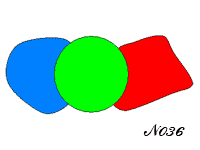 |
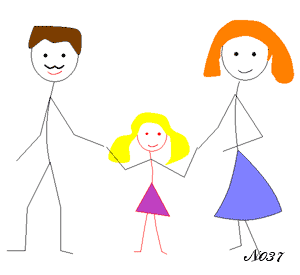 |
 |
Wrapping further links shapes when some shapes surround others, either totally or partially.
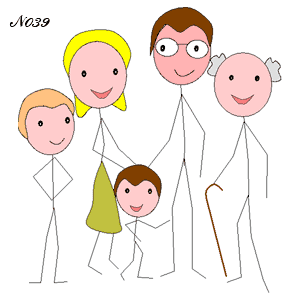 |
 |
The order of succession of similar shapes creates guidelines as well as movement.

Vectoriality : is a decrease in intensity between a central area and the peripheral areas of a coloured mass

The opening and closing of a region : shapes as visual variables can be open or closed.

See also : http://www.collegesherbrooke.qc.ca/~bourgech/semiologie/planoriginel/syntaxe.htm
Graphical language :
The graphic or visual programming language is a language in which programs are written by assembling graphic elements. Its concrete syntax consists of graphic symbols and text, which are spatially arranged to form programs. Many visual languages are based on the notions of "boxes and arrows": boxes (or other objects) are treated as entities, connected by arrows or lines that represent relationships..

Russian sentence structure :
In the Russian language, word order is flexible. Although the Russian sentence is generally organized subject-verb-object (complement), the rules of grammar allow for almost any combination of: subject, verb and object within the sentence.
For example, the sentence "A cat caught a mouse" can be translated into Russian in the following ways :
 |
 |
The order of the words does not change the meaning if the sentence is taken out of context, as you can see in the example above.
However, if the sentence is part of a particular arrangement, rearranging the words changes the meaning.
It is known that every complete sentence has a theme and a topic. The theme is one or more words that express information already known or understood. The theme is the new information that a speaker wants to communicate, for example :

(L’année dernière, mon ami a construit une maison.)
The theme is always logically emphasized in Russian. Thus, changing the order of words in the sentence causes this logical emphasis and, finally, the meaning to be changed.
Let's see how the meaning of the sentence is changed according to the word order. The theme (new information) is in bold type.
The emphasis can be placed on the fact that he built a house near a lake.

The emphasis can be on the fact that he built a house last year, not this year.

The emphasis can be on the fact that he built a house near a lake, not near a road.

The emphasis can be on the fact that son his friend, not an enemy, built a house near a lake.

See also : http://masterrussian.com/fr/aa060500a_fr.htm
4 – The child's way of thinking before the age of 4 :
Bayes' theorem :
Bayes' theorem is used to estimate the probability of an event occurring from observations, or the characteristics of a population from those of a small sample of that population. The unavoidable error decreases with increasing sample size.
https://fr.wikipedia.org/wiki/Inf%C3%A9rence_statistique
Statistics in plants :
Biologists have long been interested in plants, but it is only since 2006 that more and more of them have become interested in what has finally been decided to call "plant intelligence".
For Darwin, being intelligent, whether for a human or an animal, meant making the right decision, without presupposing the means by which that action was achieved. However, until now, many scientists considered it heresy to apply to the plant kingdom a notion reserved for the animal kingdom. But biologist Georges Bassel of Birmingham University has observed this decision-making mechanism in a seed that must, at some point, 'decide' whether or not to germinate. How does a small seed determine that the warm day that would allow it to germinate is an isolated day in the winter or the harbinger of spring? This question was answered by the seed cells of the Arabidopsis thaliana.

Without the need for neurons, the cells found at the tip of the radicle have a spatial organisation similar to some of the cognitive systems of the human brain.

This mechanism involves two types of cells and two hormones:
- the cells located at the periphery are sensitive to cold. They produce abscisic acid, a hormone that puts the radicle to sleep.
- On the other hand, the cells in the centre of the radicle grow when they wake up and produce the growth hormone gibberellin.
Between the two, a transporter diffuses each hormone into the two types of cells, each inhibiting the production of the other.

During winter, a temporary increase in temperature has little effect on the synthesis of growth hormone. It is the temperature fluctuations that gradually bring the growth hormone to the periphery of the radicle and inhibit the sleep hormone.
If the amplitude and duration of the temperature increases are insufficient, the seed will not germinate.
But if the gibberellin reaches the periphery in a sustainable way, it will indicate the coming of spring.
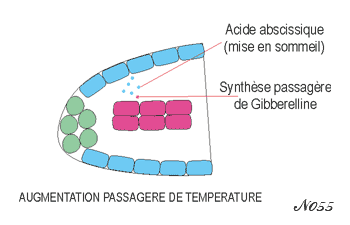 |
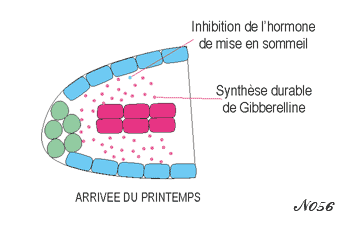 |
Swarms and artificial intelligence :
Current artificial intelligence is resolutely oriented towards learning without human intervention. Thus, a system dedicated to language will discover by itself the words, grammar and style of the writer, without knowing the deep meaning of the text.
These systems are inspired by the behaviour and decision-making capabilities of swarms of bees, flocks of birds or schools of fish.
These systems have also been studied in human groups. To do this, a group of individuals is confronted with a question and each individual, in real time, observes the behaviour of the group, chooses to change or reinforce his or her attitude, while an algorithm analyses the behaviour of each individual, his or her strength of conviction and answers the question based on the functioning of natural swarms.
In 2018, 40 non-professional swarming individuals predicted the winners of the Oscars with 94% success. Similarly, in 2016, the swarm predicted the order of arrival of the first four horses in a Kentucky derby, whereas no individual, taken separately, could have given the exact order.
It is therefore understandable that plants, made up of millions of cells, can do without a brain, since they are their own brain.
Moreover, how do our brain cells respond to the constraints of the environment? Working in swarms, they find all the answers they need, whereas none of them could have done so separately.
Could it be that the primary function of our brain-organ, which is so fast in its reactions, is to ensure movement towards food, before moving on to abstraction ?
http://www.sauvagesdupoitou.com/86/668
https://www.science-et-vie.com/nature-et-enviro/revelations-sur-l-intelligence-des-plantes-48091
http://www.up-magazine.info/index.php/technologies-a-la-pointe/lab/8545-les-graines-des-plantes-ont-en-elles-une-memoire-du-climat
Science et Vie 1203
Science et Vie 1219
Exact result :
Statistics are very important when it comes to drawing conclusions from a variable result.
Let's take the example of a maths problem in a primary school class. Out of 20 students, 10 will have the average, one will have zero (wrong solution) and one will have 20/20 (right solution).

It follows that statistics cannot indicate the exact answer to a problem. However, they do accurately describe the average level of a class. They will then allow the necessary measures to be taken to improve this general level. Generally speaking, they allow progress in all areas, both in adapting to the real world and in abstract knowledge
Number idea :
Mathematics has at least two symbolic representations: words and Indo-Arabic numbers. Used throughout the world, the latter operate in base 10, i.e. the code changes when the number 10 is reached: the numeration then switches to two digits. This code is linked to the anatomy of human hands: by analogy, our fingers represent the number 10.
Counting in base 10 means counting to infinity using our ten fingers as a base.
Learning to read :
Initially, our brain does not contain neurons designed for reading. However, its plasticity allows it to adapt to these new constraints.
Writing is in fact too recent a development in human history to have been written into our genetic make-up. It does not contain instructions or pre-established circuits for reading. Only the effort of learning allows us to recycle certain regions dedicated to other activities in order to acquire this new capacity.
We have seen that the 2-month-old baby already activates the language areas of his left hemisphere when he listens to sentences in his mother tongue [cf : 03-language / language skills at 3 months]. This hemisphere already has the neural circuits that respond to speech, and distinguish between close syllables like 'ba' and 'da'. Although the baby does not yet have a memory for words, it has the ability to produce and then imitate sounds, before being able to modulate and remember them.
At birth, the baby has no neurons for reading, but its brain already has a whole architecture dedicated to language. |
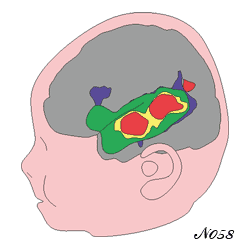 |
Thus, long before being able to read, the child masters language. Brain imaging shows that, from the very first months of life (in utero?), a baby who hears his mother tongue already activates the same brain regions as an adult.
How is speech acquired in the brain ?
Hearing is essential for language. The first transformation was therefore to link the auditory area to the language areas.

Reading, on the other hand, depends on visual areas, which are able to recognise surrounding shapes and in particular faces.

The brain does not have neurons dedicated to reading. It will have to create this new functionality.

To be able to read, the vision neurons will have to pass two tests: change their speciality to recognise letters and words, then establish a link with the word spoken by the language areas.
This ability to transform is found at all stages of evolution, and in all established structures.
During reading, and after 100 ms, activation begins in the occipital visual area [1].
70 ms later, it spreads to the left temporo-occipital region [2].
Then, multiple regions become activated in the areas of hearing, speech, including the frontal cortex [3].

Three regions can be distinguished in the visual areas,:
- a region for object recognition,
- a region for recognising faces,
- a region assigned to landscape recognition,

Why the preference for the left hemisphere ?
Because of the presence of language areas.
However, if the left occipitotemporal region is removed during the years of learning to read, the symmetrical region of the right hemisphere will take over.
Learning to read involves accessing, through vision, the areas of spoken language that are already in place in the child.
So what happens in the brain during learning to read ?
In 2010, an international team of researchers compared the brain activity of illiterate adults with that of people who were literate as children or adults. Study coordinated by Stanislas Dehaene (Collège de France, CEA-Inserm-Université Paris Sud 11 Cognitive Neuroimaging Unit, NeuroSpin/I2BM) and Laurent Cohen (Inserm, AP-HP, Université Pierre et Marie Curie).
In illiterate people, the visual area of the left hemisphere is used for object and face recognition. During learning, the response to faces decreases slightly while the response to reading increases.
Brain activation to faces is then partly transferred to the right hemisphere. The cells of the visual cortex show themselves capable of adapting to new needs and, in doing so, of abandoning an old ability to acquire a new one.
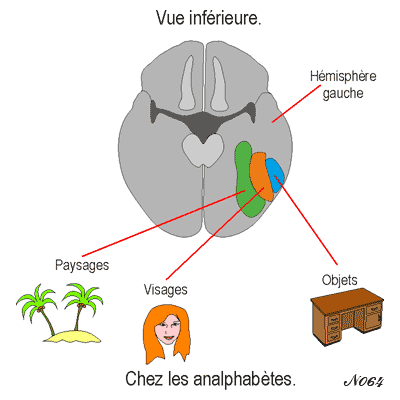 |
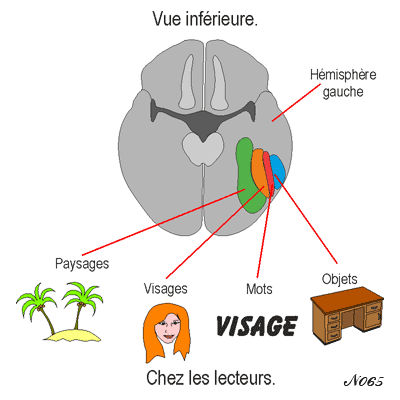 |
http://www.lecerveau.mcgill.ca/flash/pop/pop_pres/upop2013_2%20-%20pour%20pdf.pdf
https://www.u-psud.fr/fr/presse/archives/impact_de_l_apprentissage_de_la_lecture_sur_le_cerveau.html
https://presse.inserm.fr/impact-de-lapprentissage-de-la-lecture-sur-le-cerveau/14997/
https://icm-institute.org/fr/actualite/cerveau-lecture-et-ecriture/
Handling :
The adult's habit, as soon as he spots the numbers, is to read them right side up and from left to right. He will then calculate according to visible criteria such as, here, the repetition of the numbers 6 and 8, and he will look for series...
Instead, the child will manipulate the sheet of paper and, having turned it over, will discover the solution.

Montaigne, Comenius, William James :
Michel Eyquem de Montaigne (1533-1592), lord of Montaigne (Dordogne), was, according to academic traditions, either a Renaissance philosopher and moralist or a scholarly writer, precursor and founder of the "human and historical sciences" in the French language.
Comenius (1592-1670), was a Czech philosopher, grammarian and pedagogue.
William James (1842-1910) was an American psychologist and philosopher. He is often presented as the founder of psychology in America.
Phonological awareness :
Phonological awareness is the awareness that words are composed of phonemes or sounds. It allows us to perceive, chop up and manipulate the sound units of language such as the syllable, the rhyme and the phoneme. In French, there are about 36 phonemes that can be arranged to form any word in the language.
The phoneme : A phoneme is the smallest sound unit in spoken language. If we look at the letter, a phoneme corresponds to its sound. E.g.: the letter f corresponds to the phoneme ffff.
The syllable : A syllable is the fusion of phonemes that naturally cut up a word when pronounced. Ex: trunk = co and fre..
The rhyme : is made up of the vowel and the following phonemes. Ex: art = a and rt
Le graphème : est la manière dont est transcrit le d’un phonème. Ainsi, le phonème [o] peut s’écrire o – au – eau.
The grapheme : is the way in which a phoneme is transcribed. For example, the phoneme [o] can be written o - au - water.
5 – The baby, from dependence to autonomy :
Cathartic treatment :
Cathartic treatment, developed by the Austrian physician Josef Breuer, is a method using hypnosis to break down the psychological barriers that inhibit the patient's traumatic memories. These memories, which have become inaccessible, are the cause of many disorders. Being able to recall them in this way creates an emotional release that is often liberating.
Object permanence :
This is the child's knowledge that the objects around him exist when it perceives them through his senses, but also that they continue to exist, even if it no longer perceives them.
Jean Piaget, theorist of this phenomenon, thought that the child acquires this knowledge between 8 and 12 months, during the so-called sensory-motor stage of development.
New methods of observation, such as the transgression of expectations developed by Renée Baillargeon (Professor of Psychology at the University of Illinois Urbana-Champaign) in 1987, have suggested that object permanence is earlier. If we look at the eyes of infants, we see that they have expectations of objects as early as 5 months of age. However, this result remains controversial.
https://fr.wikipedia.org/wiki/Permanence_de_l%27objet
Mirror neurons:
These are neurons in the brain that are activated both when an individual performs an action and when he observe another individual performing the same action. They also activate when they imagine that action.
Considered a major discovery in neuroscience, they are thought to play a role in learning by imitation and in affective processes, such as empathy.
https://courspsycho.blog4ever.com/les-neurones-miroirs
However, their activation remains variable depending on the circumstances.
a - Impossible action :
They only activate when the movement is real, for example if the arm goes around a part of the body. If the arm passes through the body, the mirror neurons do not activate.
b - Unknown action :
For the child and the monkey who have not learned to perform a gesture, the mirror neurons do not activate.
It is essential to have acquired a motor representation of the action, whatever it may be, for the mirror system to be activated. It is not possible to represent an action if one has not mastered it.
c - Imitated action :
Mirror neurons are activated when we observe and then imitate.
d - Mimed or performed action :
In humans, miming the action of grasping an object generates much less activity than actually grasping the object.
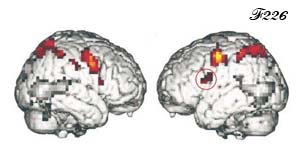 |
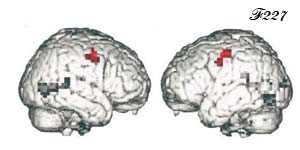 |
Action carried out. |
Mimed action. |
In the monkey, on the other hand, the neurons do not activate if we simply pretend to grasp an object. Their representational capacity only takes into account the reality of the facts.
It is not only the motor representation of gestures that is activated.
Other brain areas are involved, such as :
- the primary and secondary somato-sensory cortices in the sensation of being touched.
- the secondary somato-sensory cortex when observing someone else being touched.
Finally, this mirror system includes other systems without necessarily having mirror neurons.
Thus, when object permanence is acquired, it is not necessary to see the end of the action to see them activate.
See also :
INSERM https://apprendreaeduquer.fr/une-animation-pour-decouvrir-les-neurones-miroirs/
Appearance of language :
Towards the end of the first year and up to about 18 months, the infant utters his first words. At around 18-24 months, he or she begins to combine two words and then several words into an articulate output. Between 20 and 30 months, the child begins to use elements of syntax, such as pronouns or plural endings. Similarly, they will use grammar rules and generalise them.
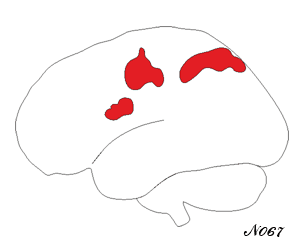 |
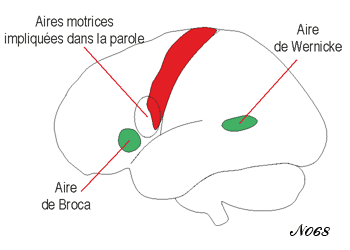 |
Neurons activated during an action or observation. |
Brain area activated during spoken language. |
The area in which mirror neurons are found corresponds to Broca's area, which specialises in spoken language.
Broca's area also controls the hands. This finding leads to the hypothesis that understanding gesture language is the first step before creating words to describe these gestures.
6– The consciousness of the child :
Introspection Network :
Study by David Edward, Imperial College London, of the brains of fetuses from 29 weeks and newborns up to the second month.
Primates :
There are many orders of mammals, with man belonging to the order of primates, whose oldest representatives are dated to 55 million years ago.
Within this order, man belongs to the family of "hominoidae" where he is related to the gibbon, the orang-utan, the gorilla and the chimpanzee. The particularity of the hominoidae is the absence of a tail. Their common ancestor acquired a nose instead of a nose (truffle), he has no vibrissae, his orbits are closed, his nostrils are open downwards, he has no third premolars and above all his caudal vertebrae are reduced to a coccyx.
A comparison of homologous genes between hominoidae indicates that human genes have greater similarities with those of the chimpanzee than with those of the gorilla, orangutan and gibbon. Together they belong to the 'hominini' branch. The chimpanzee is now considered to be the closest species to humans.
Initially, the human lineage evolved only in Africa. In the course of this evolution, "Homo sapiens" appeared 200,000 years ago and from 70,000 years ago onwards, they invaded all regions of the world, displacing the older Homo populations.
https://www.annabac.com/cours-en-ligne/l-homme-un-primate-au-sein-des-primates
https://planet-vie.ens.fr/thematiques/evolution/hominoides-hominides-hominines-et-les-autres
 >
>Reasoning by analogy :
An analogy is a comparison, a correspondence, a relationship of resemblance between two things, two people, two situations or two different concepts that have physical, intellectual, moral, etc. commonalities.
The thought process that characterises it consists in noticing a similarity between two things, of different nature or class. In fact, if the comparison concerns two things or persons of the same type, it is a resemblance,
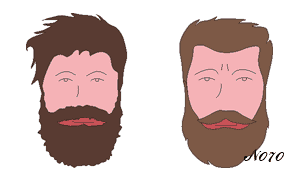 |
Resemblance. |
whereas if they are of a different class, it is an analogy.
Analogy. |
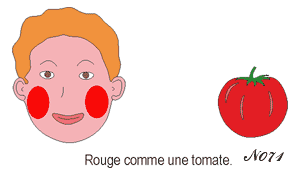 |
Analogical reasoning also allows us to match a previous situation to a new one that resembles it.
Emmanuelle Volle, a neuroscientist in the team of Bruno Dubois and Richard Lévy, has shown that reasoning by analogy depends on the most anterior region of the left prefrontal cortex. This cerebral network would allow the matching and integration of the elements necessary to form an analogy.
http://www.toupie.org/Dictionnaire/Analogie.htm https://icm-institute.org/fr/actualite/le-raisonnement-par-analogie-revisite/
fMRI :
Functional Magnetic Resonance Imaging (fMRI) is an adaptation of Magnetic Resonance Imaging that provides an indirect view of brain activity. Used to study brain function, it consists of recording local cerebral variations in blood flow when these areas are activated. Indeed, any neuronal activation will be accompanied by a local increase in blood flow in order to cover the metabolic needs linked to this activation. This will change the local ratio of oxyhaemoglobin to deoxyhaemoglobin, resulting in a magnetic signal that can be measured (BOLD signal).
More recently, techniques have also been developed to identify the fibres linking the brain areas together (diffusion method, or tractography).
https://fr.wikipedia.org/wiki/Imagerie_par_r%C3%A9sonance_magn%C3%A9tique_fonctionnelle
https://www.sciencedirect.com/science/article/abs/pii/S1957255714706777
https://www.cerveauetpsycho.fr/sd/neurosciences/voir-le-cerveau-penser-7238.php

Alison Gopnik : (born June 16, 1955) is an American professor of psychology and affiliate professor of philosophy at the University of California, Berkeley. She is known for her work in the areas of cognitive development and language, specialising in the effect of language on thought, the development of a theory of mind and causal learning.
(Le bébé philosophe. Ed Le Pommier 2010)
Mutatis mutandis : is a Latin locution, literally meaning: "what had to be changed having been changed", and which could be translated in a more current way as: "Once the necessary changes have been made". This locution thus indicates to the reader that we are going to proceed with an analogy, with a comparison of two similar situations, from which we will voluntarily subtract the dissimilarities "that must be changed" so that a comparison can take place.
Access consciousness : is the consciousness that allows us to act rationally. This consciousness would be the one on which neuroscience can work.
The notion of access consciousness is relational: it is conscious because of the relationships it has with our other thoughts, actions and speech. It is also a functional notion: conscious states are defined as those that govern reasoning and control voluntary movements.
https://fr.wikipedia.org/wiki/Ned_Block
Phenomenal consciousness : refers to the capacity to be the subject of conscious experience. It defines consciousness as a set of experiences that characterise a subject's 'experience' or 'feeling'. Unlike consciousness defined as "cognition", phenomenal consciousness is associated with qualitative experience, such as the perception of colours, the feeling of hot or cold, the feeling of anxiety, etc.
Unlike access consciousness, it is said to be non-relational and non-functional.
There are arguments for distinguishing the two consciousnesses.
Ned Block offers an everyday example that shows that there can be phenomenal consciousness without access consciousness: "I hear a lawnmower outside, and without realising it I start talking louder. Later, at some point, I realise this, and then I reason and decide to go and close the window. In a sense I was aware of the lawnmower from the start, in another sense I became aware of it at the moment I decided to close the window.
The initial awareness is phenomenal awareness, the next is access awareness. Ned Block also proposes to use this distinction to understand the Freudian notion of the unconscious. An unconscious event, according to this analysis, is a conscious event in the sense of phenomenal consciousness but not in the sense of access consciousness.
https://fr.wikipedia.org/wiki/Conscience_ph%C3%A9nom%C3%A9nale
https://fr.wikipedia.org/wiki/Ned_Block

Development of awareness.
1st time : the phenomenon is perceived and taken into account, without the consciousness having access to it ;
2nd time : the consciousness accesses the existence of the phenomenon.
1st time : the phenomenon is perceived and taken into account, without the consciousness having access to it ;
2nd time : the consciousness accesses the existence of the phenomenon.
Statistics in babies : The statistical frequency of sounds influences the brain of toddlers.
In a study of 6-month-olds in Seattle, USA, and Stockholm, Sweden, it was shown that each group was already focusing on the vowels of their native language. The language environment starts to permeate the baby's brain at an early age and influences the way the baby perceives sounds.
It seems that learning sounds between 6 and 12 months of age establishes connections in the brain associated with the child's mother tongue and those to which the child is exposed during this period.
A second form of statistical language learning allows children to recognise words as a whole: Jenny Saffran, now at the University of Wisconsin at Madison, and her colleagues were the first to discover that babies use statistical learning to pick up the sounds of whole words. In the mid-1990s, they published data showing that an 8-month-old child learns basic word-like units based on the probability that one syllable will follow another.
Statistics is the discipline that studies phenomena through the collection of data, their processing, analysis, interpretation of results and presentation to make the data understandable to all. It is at the same time a science, a method and a set of techniques.
https://www.pourlascience.fr/sd/neurosciences/le-bebe-un-linguiste-en-herbe-9145.php
https://fr.wikipedia.org/wiki/Statistique
Causal reasoning : is reasoning based on the principle that every fact has a cause and that a cause produces effects. This reasoning is often used to explain a fact, in a simple, sometimes naive, but understandable way, in science or in everyday life.
https://www.fondation-lamap.org/fr/page/34822/le-raisonnement-causal-chez-lenfant
Antonio Damasio , professor of neuroscience, neurology and psychology, heads the Brain and Creativity Institute at the University of Southern California, Los Angeles.
He is an adjunct professor at the Salk Institute in La Jolla.
Evolution of the nervous system :
In animals, the central nervous system integrates sensory information and sends motor commands throughout the body. In vertebrates, the brain has a peripheral cortex organised into cell layers, whereas in arthropods and annelid worms, it is characterised by the presence of rounded sensory structures, the pedunculated bodies. However, it seems that an outline of the vertebrate nervous system was already established in the Precambrian: the cerebral cortex of vertebrates and the pedunculated bodies of annelids would have the same ancestral origin: a nervous structure that differentiated in a common ancestor living in the sea 600 to 550 million years ago.
From this common origin, more than 500 million years of divergent evolution have made them very different.

The annelid worm Platynereis dumerilii.
In the course of animal evolution, neurons - electrically active cells that appeared in cnidarians (jellyfish, anemones) some 680 million years ago - grouped together into ganglia when organisms acquired bilateral symmetry.By studying larvae of the marine annelid worm Platynereis dumerilii, the researchers produced a 3D genetic map of the developing pedunculated bodies, which they compared with that of the pedunculated bodies of the Drosophila embryo and that of the cerebral cortex, or pallium, of the mouse embryo.
The researchers concluded that the two molecular fingerprints are "too similar to be of independent origin, so these organisms must have a common precursor".
Urbilateria, the possible common ancestor, is thought to resemble a kind of marine worm with one or more neural nuclei capable of integrating sensory signals from the environment. Later, this basic neural plan would have evolved into more complex structures until it reached the level we know in mammals.

Possible common ancestor of annelid worms.
https://www.pourlascience.fr/sd/neurosciences/un-cerveau-ancestral-de-600-millions-dannees-10679.php
Homeostasis balance : Defined by Claude Bernard, it is the capacity of any system to maintain its functional equilibrium despite external constraints (regulation of temperature, blood sugar...).
Protoself : The "self" refers to the knowledge of the self, emerging from the perceptual-motor system, which allows one to distinguish and differentiate oneself from the rest of the world.
In its most primitive form, it is referred to as protosoi.
Produced by the protosoi and originating in the brain stem, the primordial feelings (pleasure and pain) reflect the state of the body. They then expand into the various emotional feelings. Even the most complex mental images that are not feelings exist only because they are coupled with feelings.
https://fr.wikipedia.org/wiki/Ant%C3%B3nio_Dam%C3%A1sio
The thalamus : The thalamus is the main diencephalic nucleus. Its many nuclear subdivisions relay motor, sensory, sensory and associative information.
It is thought to be involved in :
- in the waking state, in the transfer and filtering of peripheral sensory information to the cortex, and in the general activation of the cerebral cortex (vigilance).
- during slow wave sleep, in the disconnection of the cortex from sensory stimuli, and in memory consolidation processes.
http://www.chups.jussieu.fr/ext/neuranat/morphologie/GanglionsBase/index.html https://fr.wikipedia.org/wiki/Thalamus
Basal ganglia :
The anatomical definition of the basal ganglia includes:
- the zoom striated body (putamen, globus pallidus and caudate nucleus)
- the claustrum (front wall)
- the amygdala
The amygdala complex is usually studied as part of the limbic system.br>br> The ventral tegmental area (VTA), a group of neurons located in the centre of the brain, is particularly important in the reward circuit. It receives information from several other regions that inform it about the level of satisfaction of basic or more specifically human needs.
Scientists have discovered two different signals carried by two types of neurons that run through the motivational circuit in the ventral pallidum. Inhibitory signals are responsible for reward-seeking and pleasure-seeking behaviour, and excitatory signals cause the mice to flee from stress.
The amygdala is a collection of subcortical nuclei located in the rostral medial temporal lobe. The different nuclei are :
- the basolateral nuclei which receive projections from the cortical sensory and associative areas of the temporal lobe and insula.
- the central nuclei which participate in emotional responses. They receive viscerosensory afferents from the solitary and parabrachial nuclei, as well as from the basolateral nuclei of the amygdala.
- The corticomedial nuclei exchange information with the olfactory bulb. They are thought to be involved in the emotional regulation of olfactory stimuli (feeding and reproductive behaviour).br> http://lecerveau.mcgill.ca/flash/d/d_03/d_03_cr/d_03_cr_que/d_03_cr_que.html
https://www.sciencesetavenir.fr/sante/cerveau-et-psy/comment-le-cerveau-trace-t-il-la-frontiere-entre-plaisir-et-douleur-essentielle-a-notre-motivation_140247
https://fr.wikipedia.org/wiki/Syst%C3%A8me_limbique
Merging with the Universe : Shamans or Buddhist monks, among others, train to modulate their brain waves through meditation or techniques leading to trance or ecstatic state. In the West, other methods grouped in the teaching of sophrology aim to study or obtain changes in the state of consciousness. In all these methods the subject loses more or less the notion of self, space and time.
In the most extreme states, the subject can experience total fusion with the universe, with a feeling of wisdom and infinite love.
https://www.sciencesetavenir.fr/sante/cerveau-et-psy/le-cerveau-dans-tous-ses-etats_107838
https://www.pourlascience.fr/sd/neurosciences/comment-la-meditation-modifie-le-cerveau-8322.php
Insects and personality : Ants reveal the incredible ability of insects to act like the most advanced organisms. They are able to associate and cooperate for the common good. Building complex shelters or searching for food, some may also find no employment at all. They may also wage war against other colonies and take slaves.
In Côte d'Ivoire, observations of the fight between these insects and termites have revealed quasi-military habits and a very efficient army health service.
In 2017, researchers observed members of the Megaponera analis family rescuing one of them, carrying it and returning it to the nest. Since then, they have been able to film ants applying their antibacterial saliva to the wounds of their wounded victims, which enables them to fight infection. This technique allows them to save 80% of their fellow ants.
https://www.lemonde.fr/sciences/article/2018/03/12/les-fourmis-redoutables-strateges-militaires_5269745_1650684.html